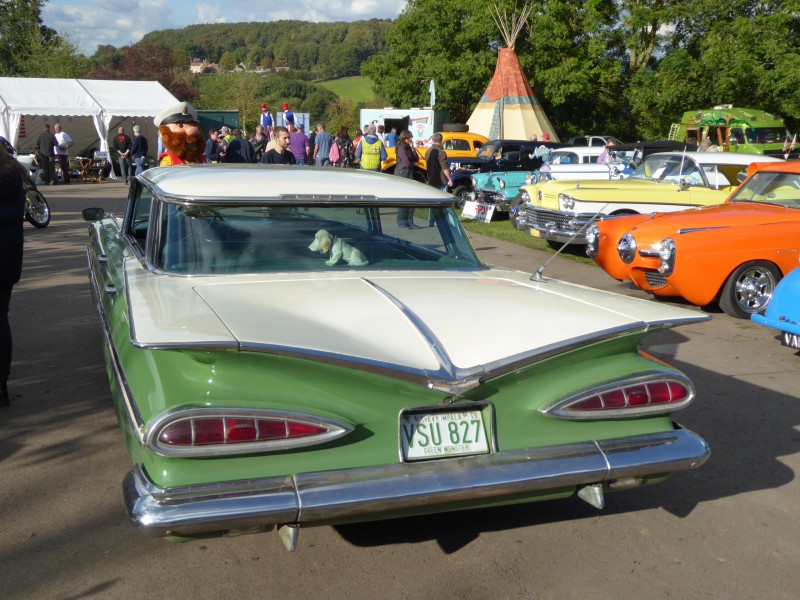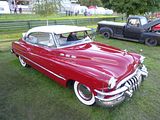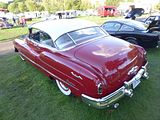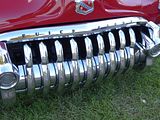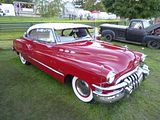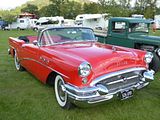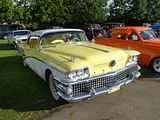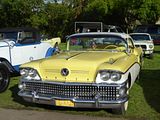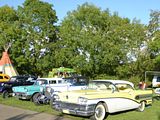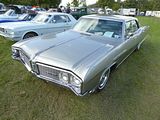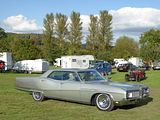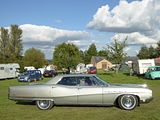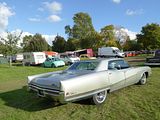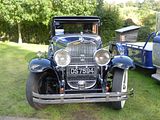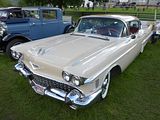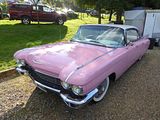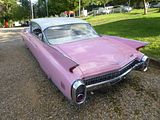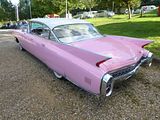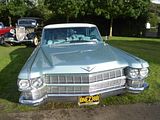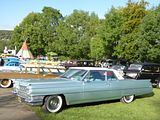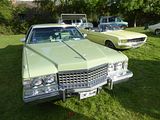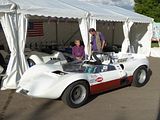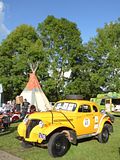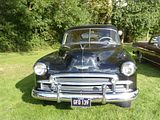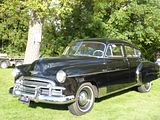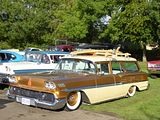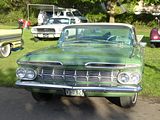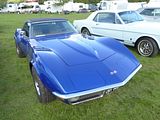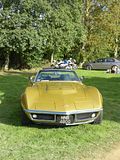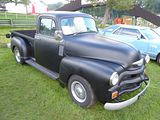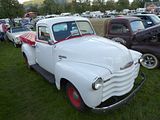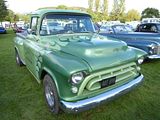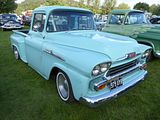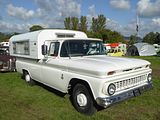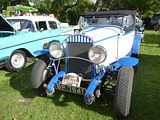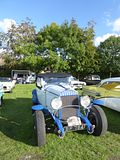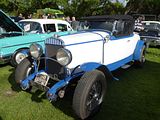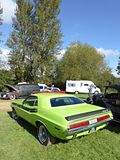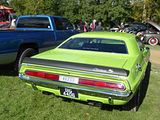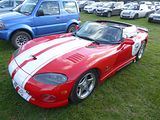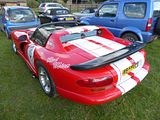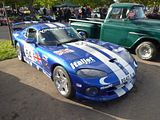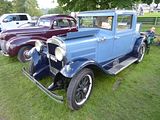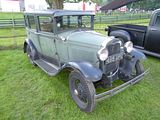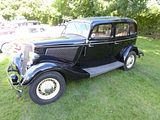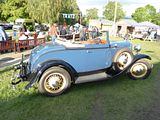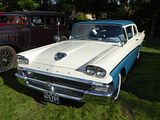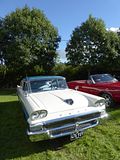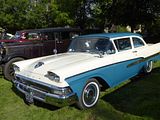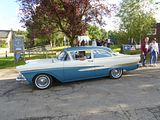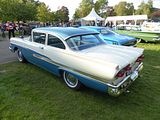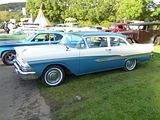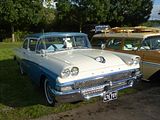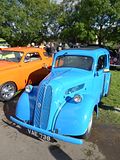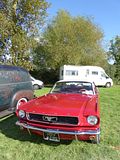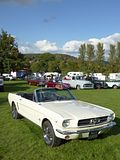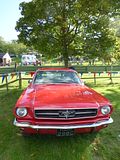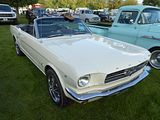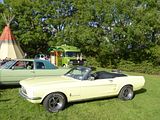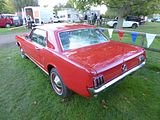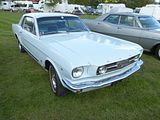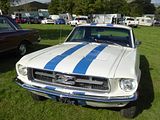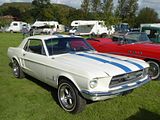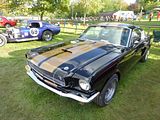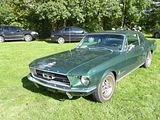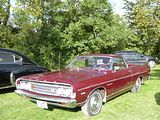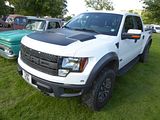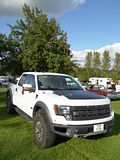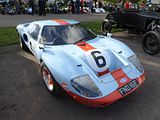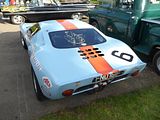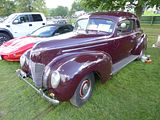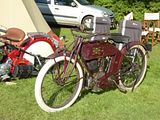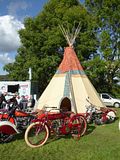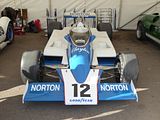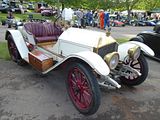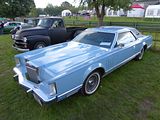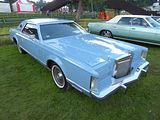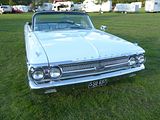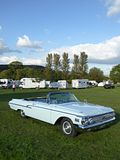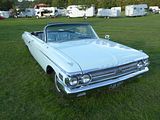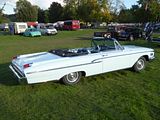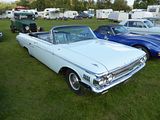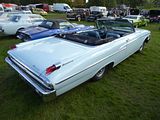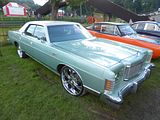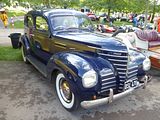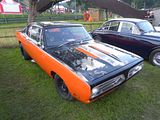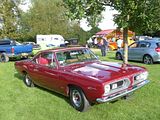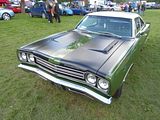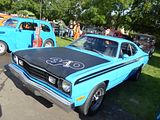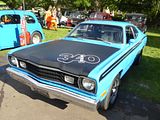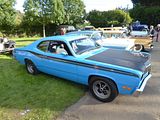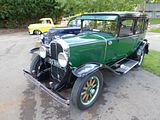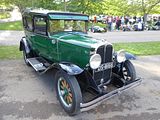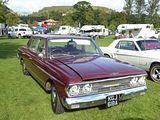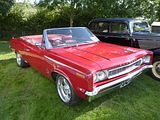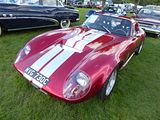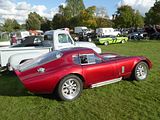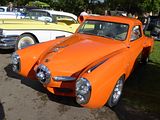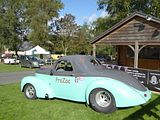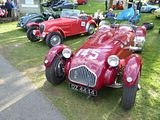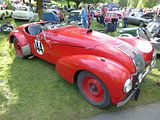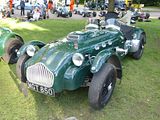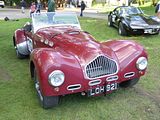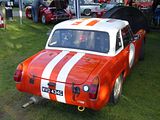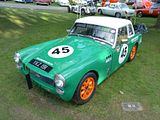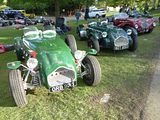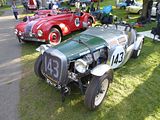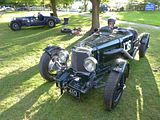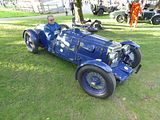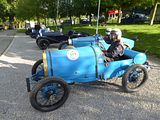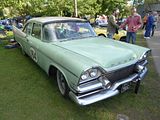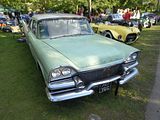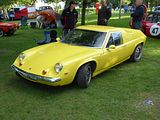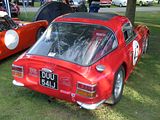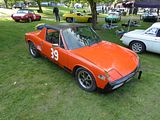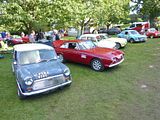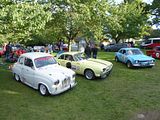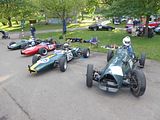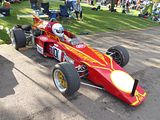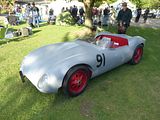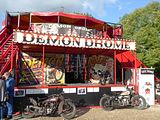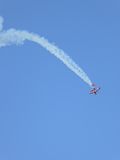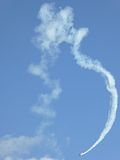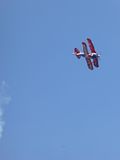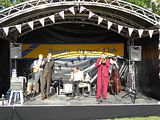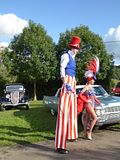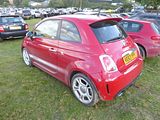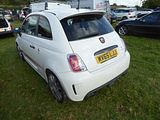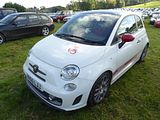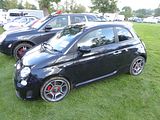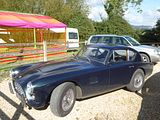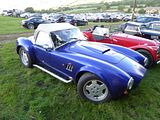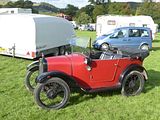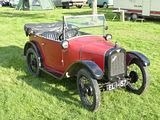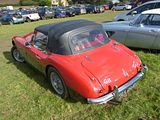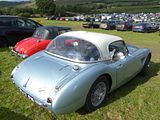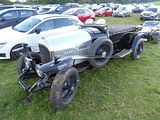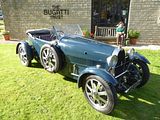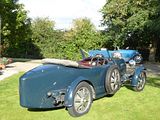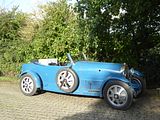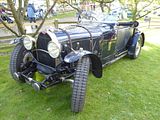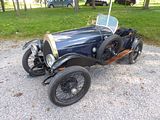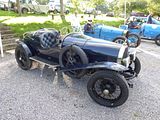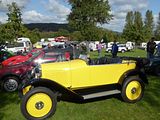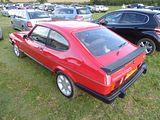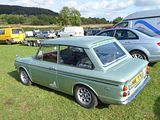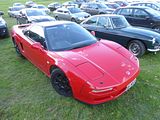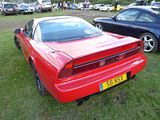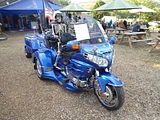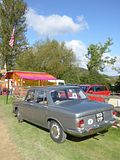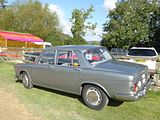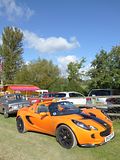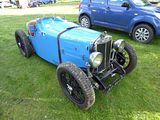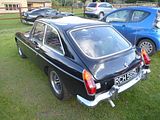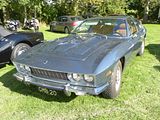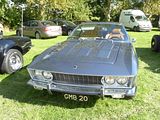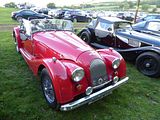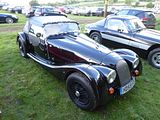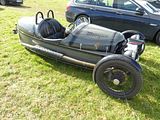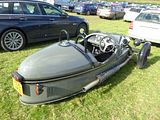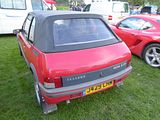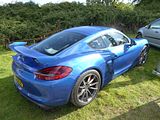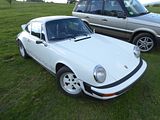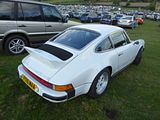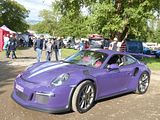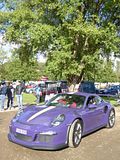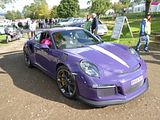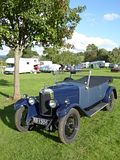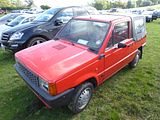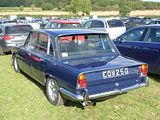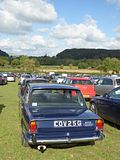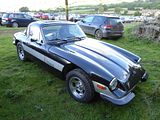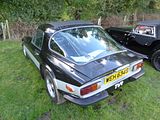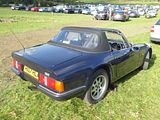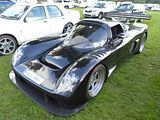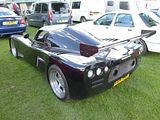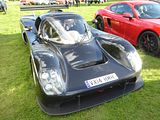For some years now, the season finale at the Prescott Hill Climb venue has had an American theme. Whilst the setting changes only to reflect the seasons, so by early October, this idyllic place is in its autumn plumage, with leaves at their colourful best and the fruit from the trees in the orchard more on the ground than still attached the trees, but the atmosphere feels quite different when Americana dominates, as opposed to the far more restrained Bugatti and other French machinery that you see earlier in the year, or the vast array of pre-war cars at the VSCC gathering in early August. The theme has certainly struck quite a chord with both participants and attendees, though, with every year bringing a greater American presence to the Paddock and the Orchard parking areas, a mix of cars returning and some new finds making the journey to this north Gloucestershire venue. Much of this success goes down to event supremo, Rebecca Leppard, who spends months before an event like this, coming up with all sorts of imaginative ideas and then using her vast network of contacts to bring her ideas to reality. I happen to know that she has her own American classic and is a huge fan of the genre, so it should surprise no-one that this is such a good event. Early October is a popular time for season finale events, and so whilst the Prescott Autumn Classic is spread over two days, I was only able to attend on one of them, the Sunday. There was plenty to see, as this report will evidence.
AMERICANA
To reinforce the American theme, special display areas are reserved both for the Paddock and a sizeable area of the Orchard, for American cars. Both were well populated, with quite a variety of different models, of all ages from pre-war to much more recent. Although few American cars have been sold new in the UK over the years, there are more here than you might think, and an event like this proves the point. Some were cars which I have seen here before, but there were plenty that I have not.
BUICK
The oldest Buick to be seen here was a Super dating from around 1950. This was the third generation to bear the Super name, and was produced from 1949 to 1953. The Super shared a new General Motors C-body with the Roadmaster but on a shorter wheelbase. It featured three chrome VentiPorts on each front fender to denote its smaller straight-eight engine and shorter engine compartment when compared with the Roadmaster. The sales brochure noted that VentiPorts helped ventilate the engine compartment, and possibly that was true in early 1949, but sometime during the model year they became plugged. The idea for VentiPorts grew out of a modification Buick styling chief Ned Nickles had added to his own 1948 Roadmaster. He had installed four amber lights on each side of his car’s hood wired to the distributor so as to flash on and off as each piston fired simulating the flames from the exhaust stack of a fighter airplane. Combined with the bombsight mascot, VentiPorts put the driver at the controls of an imaginary fighter airplane. Upon seeing this, Buick chief Harlow Curtice was so delighted that he ordered that (non-lighting) VentiPorts be installed on all 1949 Buicks. Super script was found just above the full length body fender moulding on the front fenders. New fender edge taillamps were featured while rear fender skins remained a Buick standard. New fender top parking lamps, harkening back to 1941 styling appeared. Full wheel trim discs were standard along with such features as a cigar lighter, ashtray, and automatic choke. Cloth interiors were standard, except on the convertible which was trimmed in leather and leatherette and had a power top, seat and windows as standard equipment. Dynaflow automatic transmission was now optional equipment on Supers in 1949. Cars so equipped had 6.9:1 compression ratio and 120 bhp. Total sales set a record at 190,514 for the first time since the Super’s introductory year. The instrument panel was new. The 1950 Supers shared with all the other series totally new all bumper guard grille and more rounded styling. Super script appeared on front fenders just above the full length lower bodyside mouldings. A new body style was a 2-door Riviera hardtop. Another new bodystyle was a long wheelbase sedan which was stretched an extra four inches and featured plusher interior than most Supers, which normally had cloth interiors of finer material than the Special. Supers had three VentiPorts on each side of the bonnet. The convertible had leather power seats plus power windows and top. The 1950 Super came with a single two-barrel carburettor on a new higher displacement 263 cu in (4.3 litre) Fireball I8 which produced 112 hp. It was able to achieve speeds over 90 mph with an optional Dynaflow automatic transmission which, rather than changing through gears, used the torque converter to couple the motor to a single gear ratio. The car had 2 splits in the back glass although the windshield was now curved one-piece glass. Models also could be equipped with an AM radio and an antenna that could be adjusted via a knob in the front centre above the windshield. In the June 1953 Popular Mechanics, acceleration was rated at 0-60 mph in 14.5 seconds. The Super set an all time record of 251,883 sold. In 1951 Supers had larger bodies than Specials but looked similar with three rounded VentiPorts per fender, broad bright fender shields and a full length “Sweepspear” chrome body side moulding. This chrome-plated strip started above the front wheel, after which it gently curved down nearly to the rocker panel just before the rear wheel, and then curved around the rear wheel in a quarter of a circle to go straight back to the taillight. Series script was found on the deck lid and within the steering wheel centre. The long wheelbase sedan was named the Riviera sedan although it was not a hardtop. Supers were trimmed with materials similar to Special Deluxes except for in the plush Super Riviera sedan. Front turn signals were within the bumper guard “bombs,” while rear signals shared the stop lamps’ housing on the rear fender edges. The convertibles and Estate wagon were trimmed in leather. 169,226 Supers were sold. In 1952 Buick’s mid-priced line resembled the Series 40 with three VentiPorts per fender and Sweepspear rocker panel trim. Super script appeared on the rear fenders aided identification. The Super was built with the larger C-body, however. The full flowing fenderline dipped deeper on this body and rear fenders had a rear crest line absent on the B-body Specials. A new deck lid gave a more squared off appearance. Like other Buick series it was a near copy year for 1952. Chromed rear fender fins gave distinction to 1952 Supers. Interiors were cloth except on convertibles and Estate wagons which were trimmed with leather. The Super used a different instrument panel than the Special. It was distinguished by a large centre speedometer housing flanked by smaller gauge housings. Series identification was found within the steering wheel center. The Sedanet and the regular wheelbase sedan were cancelled. Sales fell to 135,332. In 1953 Buick’s middle priced line shared the Roadmaster’s new V8 and, for this year the Roadmaster shared the Super and Special’s 121.5 in (3,086 mm) wheelbase. The Super earned a horizontal trim bar on its rear fenders which distinguished it from the Series 70 Roadmasters. Otherwise its side trim bar on its rear fenders was identical although the Super had only three VentiPorts on each front fender. Series identification was found on the deck emblem. Full wheelcovers were now standard. The vee in the bombsight ornament signified the V8 power under the hood. Interiors in most models were nylon and silky broadcloth. The convertible had power windows, seat and top as standard equipment. Dynaflow was now standard equipment. Air conditioning was a new option. A total of 190,514 Supers were sold.
Buick used the Special badging on their lowest price model range for many years. Between 1936 and 1958, it was applied to a full-sized model, before the badge had a couple of years rest, only to return on a smaller car There were three Buick Specials here, showing the evolution of the model during the 1950s, Halfway into the 1949 model year, the Specials received all-new bodywork, the first fully postwar design for the series. New was also the 40D-series, a better equipped version called the Special DeLuxe. The engine remained the 248 cu in (4.1 litre) which had been used since 1937, but for 1951 this was replaced by the larger “Fireball” straight-eight. A two-door hardtop coupe was also new for 1951. The 1954 Specials had an all-new body and chassis, much wider and lower, and were now equipped with the all-new, more powerful “Nailhead” V8 engines. The model seen here dates from 1952.
Introduced in the middle of the 1955 model year the four-door Buick Special Riviera (along with the Century Riviera, the Oldsmobile 98 Holiday, and the 88 Holiday) were the first four-door pillarless hardtops ever produced. By then, the Buick Special was one of America’s best selling automotive series. It was available in a variety of body styles including this rather nice convertible.
For 1956 the larger 322 cu in (5.3 litre) V8 engine was shared with the rest of the range, although it was replaced by the bigger, 250 hp 364 V8 for 1957. This year also brought all-new bodywork, as well as a four-door hardtop station wagon called the Buick Caballero. The 1957 wheelbase remained 122 inches. In the June, 1957 issue of Popular Mechanics, the Special was rated with a 0-60 mph time of 11.6 seconds, fuel economy of 17.4 mpg at 50 mph and ground clearance of 6.9 in. 1958 brought the most chrome yet and twin headlights, and the car grew longer and wider making it look quite different, even though it sat on an unchanged chassis. This striking car dates from 1958, and is one that I have seen at Prescott a number of times. It just oozes America, and attracts lots of interest whenever it is shown.
Buick first used the name Electra in 1959, and it was continuously applied to the top models in the range right through to 1990. Classical scholars may think that the name came from Greek mythology, but in fact, it was the name of the President of General Motors’ sister-in-law, Electra Waggoner Biggs. Seen here is an Electra 225 from 1969. That model year saw a major restyling to the car and indeed the other GM B-body and C-body cars with somewhat crisper bodylines than the 1965–68 models, even though these new cars continued with the same chassis and inner body structure that had been introduced with the 1965 model. This was an era of huge cars, so the wheelbase was increased one inch to 127-inch.
CADILLAC
Oldest Cadillac here was this 1929 Fleetwood 341-B car. The 341-B, announced for 1929, was an upgrade of the earlier 341, with a slight increase in power from its 5.5 litre straight 8 engine. An optional low compression engine was offered. The biggest change was the introduction of a syncro-mesh transmission which facilitated easier gear changes. Smaller details included slightly larger tyres, Duplex-Mechanical brakes, double-acting Delco shock absorbers, chrome plated brightwork and electric windshield washers. A Series 341-B Commercial Chassis was available with a longer wheelbase of 152 inches. Five million dollars was put into upgrades at the factory, but the intended market growth was crushed by the Stock Market Crash. A total of 18004 of both the 341 and 341-Bs were built and in 1930 the model was replaced by the Series 353 which featured a slight increase in engine displacement.
This one dates from 1958. Cadillac introduced its first production four-door hardtop, the Sedan DeVille, in 1956. When Cadillac redesigned all of its standard models for 1957, the Sixty Special adopted the pillarless design as well. Priced at a hefty $5,539, the 4,761 lb (2,160 kg) Sixty Special production reached an impressive 24,000 units – a sales plateau that the nameplate would never achieve again. The chrome fender louvres, a Sixty Special trademark since 1942, were gone in favour of a giant ribbed metallic panel that occupied the entire lower half of the rear fender. The Sixty Special script was located on the lower half of the front fender, and was relocated to the top of the rear fin for 1958, and the word “Fleetwood” was spelled out in block lettering across the boot lid. Engineering treats included moving the optional air conditioning unit from the boot to a space under the bonnet, and a foot-operated parking brake that released when the car was put in gear. The 365 cu in (5.98 litre) engine introduced last year was now bumped up to 300 bhp. In spite of all-new sheet metal on the 1957 models, much of Cadillac’s attention was focused on the new limited production Eldorado Brougham. This new four-door model did not pose a threat to Sixty Special production, since the new Brougham was a hand-built, limited-production specialty model with a stupendously steep $13,074 price tag – more than double a new Sixty Special. Power windows and brakes were standard. A pre-selector radio was optional. 1958 saw extensive design changes, even though the cars were entirely revamped for 1957. Horsepower from the 365 cu in (5.98 litre) engine was now at 310 bhp. Sparkling “studs” decorated the wide new grille, while the rubber-tipped bumper guards were moved further out towards the edges of the car – leaving a lower, wider look. Four headlights, a style that appeared on last year’s Eldorado Brougham, were adopted for all Cadillacs, including the $6,117 Sixty Special. Full fender skirts practically hid the rear wheels from sight, and the massive ribbed stainless steel trim occupied the lower half of the rear fender. Small vent windows were added to Sixty Special’s rear doors, and newly available power door locks were optional. This marked the last year that the Sixty Special would maintain a stretched GM C-Body until its return in the 1965 model year. The model year 1958 would also be the last that the Sixty Special script would actually appear anywhere on the car. Sales for the 4,930 pound car slid to 12,900 units – nearly half of the previous year’s production.
The 1959 Cadillac is remembered for its huge sharp tailfins with dual bullet tail lights, two distinctive rooflines and roof pillar configurations, new jewel-like grille patterns and matching deck lid beauty panels. In 1959 the Series 62 had become the Series 6200. De Villes and 2-door Eldorados were moved from the Series 62 to their own series, the Series 6300 and Series 6400 respectively, though they all, including the 4-door Eldorado Brougham (which was moved from the Series 70 to Series 6900), shared the same 130 in wheelbase. New mechanical items were a “scientifically engineered” drainage system and new shock absorbers. All Eldorados were characterised by a three-deck, jewelled, rear grille insert, but other trim and equipment features varied. The Seville and Biarritz models had the Eldorado name spelled out behind the front wheel opening and featured broad, full-length body sill highlights that curved over the rear fender profile and back along the upper beltline region. Engine output was an even 345 hp from the 390 cu in (6.4 litre) engine. Standard equipment included power brakes, power steering, automatic transmission, back-up lamps, two-speed wipers, wheel discs, outside rearview mirror, vanity mirror, oil filter, power windows, six way power seats, heater, fog lamps, remote control deck lid, radio and antenna with rear speaker, power vent windows, air suspension, electric door locks and license frames. The Eldorado Brougham also came with air conditioning, automatic headlight dimmer, and a cruise control standard on the Seville and Biarritz trim lines. For 1960, the year that this Fleetwood Eldorado was made, the styling was toned down a little. General changes included a full-width grille, the elimination of pointed front bumper guards, increased restraint in the application of chrome trim, lower tailfins with oval shaped nacelles and front fender mounted directional indicator lamps. External variations on the Seville two-door hardtop and Biarritz convertible took the form of bright body sill highlights that extended across the lower edge of fender skirts and Eldorado lettering on the sides of the front fenders, just behind the headlamps. Standard equipment included power brakes, power steering, automatic transmission, dual back-up lamps, windshield wipers, two-speed wipers, wheel discs, outside rearview mirror, vanity mirror, oil filter, power windows, six-way power seats, heater, fog lamps, Eldorado engine, remote control trunk lock, radio with antenna and rear speaker, power vent windows, air suspension, electric door locks, license frames, and five whitewall tyres. Technical highlights were finned rear drums and an X-frame construction. Interiors were done in Chadwick cloth or optional Cambray cloth and leather combinations. The last Eldorado Seville was built in 1960. The idea of a large car finished in pink now is simply unthinkable, but the colour goes quite well with the style here. These 59 and 60 Cadillacs attract lots of interest from collectors and the public and this one was no exception.
Showing rather more restraint in its styling was this 1964 Coupe de Ville. This comes from the second series of Cadillac to bear the Coupe de Ville name. Cadillac had restyled and re-engineered this model for 1961. A new grille slanted back towards both the bumper and the hood lip, along the horizontal plane, and sat between dual headlamps. New forward slanting front pillars with non-wraparound windshield glass were seen. The revised backlight treatment had crisp angular lines with thin pillars on some models and heavier semi-blind quarter roof posts on others. De Ville models featured front series designation scripts and a lower body “skeg” trimmed with a thin, three-quarter-length spear moulding running from behind the front wheel opening to the rear of the car. Standard equipment included power brakes, power steering, automatic transmission, dual backup lights, windshield washer, dual speed wipers, wheel discs, plain fender skirts, outside rearview mirror, vanity mirror, oil filter, power windows and 2-way power seats. Rubberised front and rear coil springs replaced the trouble prone air suspension system. Four-barrel induction systems were now the sole power choice and dual exhaust were no longer available. A new short-decked four-door Town Sedan hardtop appeared mid-season. A mild face lift characterised Cadillac styling trends for 1962. A flatter grille with a thicker horizontal centre bar and more delicate cross-hatched insert appeared. Ribbed chrome trim panel, seen ahead of the front wheel housings in 1961, were now replaced with cornering lamps and front fender model and series identification badges were eliminated. More massive front bumper end pieces appeared and housed rectangular parking lamps. At the rear tail lamps were now housed in vertical nacelles designed with an angled peak at the centre. A vertically ribbed rear beauty panel appeared on the deck lid latch panel. Cadillac script also appeared on the lower left side of the radiator grille. The short-deck hardtop Town Sedan was moved from the De Ville series to the Series 6200, being replaced by a short-deck Park Avenue. In addition all short deck Cadillac models went from being 6-window sedans in 1961 to 4-window sedans in 1962 and 1963. Standard equipment included all of last year’s equipment plus remote controlled outside rearview mirror, five tubeless black wall tires, heater and defroster and front cornering lamps. Cadillac refined the ride and quietness, with more insulation in the floor and behind the firewall. De Ville sales as a separate series exceeded their sales level as a trim level for the first time ever at 71,883 units, or nearly 45% of Cadillac’s total sales. The 1963 Cadillac was essentially the same as the previous year. Exterior changes imparted a bolder and longer look. Hoods and deck lids were redesigned. The front fenders projected 4.625 inches further forward than in 1962 while the tailfins were trimmed down somewhat to provide a lower profile. Body-side sculpturing was entirely eliminated. The slightly V-shaped radiator grille was taller and now incorporated outer extensions that swept below the flush-fender dual headlamps. Smaller circular front parking lamps were mounted in those extensions. A De Ville signature script was incorporated above the lower beltline molding near the rear of the body. A total of 143 options including bucket seats with wool, leather, or nylon upholstery fabrics and wood veneer facings on dash, doors, and seatbacks, set an all-time record for interior appointment choices. Standard equipment was the same as the previous year. The engine was entirely changed, though the displacement and output remained the same, 390 cu in (6.4 litre) and 325 hp. There was another facelift in 1964 and really a minor one. New up front was a bi-angular grille that formed a V-shape along both its vertical and horizontal planes. The main horizontal grille bar was now carried around the body sides. Outer grille extension panels again housed the parking and cornering lamps. It was the 17th consecutive year for the Cadillac tailfins with a new fine-blade design carrying on the tradition. Performance improvements including a larger V-8 were the dominant changes for the model run. Equipment features were same as in 1963 for the most part. Comfort Control, a completely automatic heating and air conditioning system controlled by a dial thermostat on the instrument panel, was introduced as an industry first. The engine was bumped to 429 cu in (7 litre), with 340 hp available. Performance gains from the new engine showed best in the lower range, at 20 to 50 mph traffic driving speeds. A new technical feature was the Turbo-Hydramatic transmission, also used in the Eldorado and the Sixty Special. A De Ville script above the lower belt moulding was continued as an identifier. This was the first year for the De Ville convertible. De Ville sales reached 110,379 units, accounting for nearly two thirds of all Cadillacs sold.
This 1973 Coupe de Ville dates from the era when the “Land Yacht” was at its apogee. This body style was produced from 1971 through to 1976. With 64.3 inches front shoulder room (62.1 inches on Cadillac) and 63.4 inches rear shoulder room (64.0 inches on Cadillac) the new for 1971 full-sized GM cars set a record for interior width that would not be matched by any car until the full-size GM rear-wheel-drive models of the early to mid-1990s. The styling of the new Cadillacs bore a strong resemblance to the models they replaced, but there were differences. Pairs of individually housed squarish headlamps were set wider apart. The V-shaped grille had an eggcrate style insert and was protected by massive vertical guards framing a rectangular license plate indentation. A wide bonnet with full-length windsplints, a prominent centre crease and hidden windshield wipers was seen. A Cadillac crest decorated the nose and new indicator lamps appeared atop each front fender. A horizontal beltline moulding ran from behind the front wheel housing, almost to the rear stopping where an elliptical bulge in the body came to a point and where thin rectangular side markers were placed above and below the chrome strip. The rear wheel openings were again housed in fender skirts. Tail lamps were of the same type as before but were no longer divided by a chrome bar. Long horizontal back-up lamps were set in the bumper, on either side of a deeply recessed license plate housing. De Villes were set apart visually by thin bright metal rocker panel steps and signature script on the front fenders bearing the series name. The bottoms of the rear fenders were decorated with a bright metal beauty panel that was wider than the rocker panel strips and blended into the moulding running along the bottom of the fender skirt. The standard engine remained the 472, still rated at 375 SAE gross hp and 365 lb/ft of torque. Detailed styling changes were made every year throughout the 5 year production run, with energy absorbing bumpers appearing in 1973, a year in which sales set a new record at 216,243. 1974 saw the introduction of the optional “Air Cushion Restraint System”. Known today as airbags, this option provided protection for front seat occupants in the case of a frontal collision. One bag was located in the steering wheel, the other in the dashboard in front of the front seat passenger. The glove box was replaced with a lockable storage compartment under the dashboard. The option was unpopular and was discontinued after the 1976 model year.
CHAPARRAL
Making another appearance at this event were a pair of Chaparral cars. Named after a fast-running ground cuckoo that is commonly known as a chaparral or a roadrunner, Chaparral Cars was an American racing team which was founded in 1962 by Formula One racer Hap Sharp and Jim Hall, a Texas oil magnate with both engineering and race car driving skills. Jim Hall raced the front-engined Chaparral (retroactively called the “Chaparral 1”) through 1962, bought from Troutman & Barnes (like the Scarab, the Chaparral 1 cars were built in California by Troutman & Barnes). Hall and Hap Sharp extensively modified their Chaparral, and eventually decided to build their own car. They obtained permission from Troutman & Barnes to use the Chaparral name, which is why all of Hall’s cars are called Chaparral 2s. The two cars on show here were Chaparral 2 models. The first Chaparral 2-Series was designed and built to compete in the United States Road Racing Championship and other sports car races of the time, particularly the West Coast pro Series races that were held each autumn. Hall had significant “under the table” assistance from GM, including engineering and technical support in the development of the car and its automatic transmission (this is evidenced by the similarity between the Chevy Corvette GS-II “research and development” car and the Chaparral 2A through 2C models). First raced in late 1963, the Chaparral 2 developed into a dominant car in the CanAm series in 1966 and 1967. Designed for the 200 mile races of the CanAm series, it was also a winner in longer endurance races. In 1965 it shocked the sportscar world by winning the 12 Hours of Sebring in a pouring rain storm, on one of the roughest tracks in North America. The Chaparral 2 featured the innovative use of fibre glass as a chassis material. The Chaparral 2C had a conventional aluminium chassis. It is very difficult to identify all iterations of the car as new ideas were being tested continually. The 2A is the car as originally raced, featuring a very conventional sharp edge to cut through the air. It also featured a concave tail reminiscent of the theories of Dr. Wunibald Kamm. The first aerodynamic appendages began to appear on the 2A almost immediately to cure an issue with the front end being very light at speed with a consequent impact on steering accuracy and driver confidence. As the car evolved, it grew and changed shape. Most call these the 2B, as raced through the end of 1965. The cars on show here were a 2A and a recreation of the 2B. One of them made a number of sorties up the hill, and you knew when it was being prepared, as the noise was really something else.
CHEVROLET
Oldest Chevrolet here was a 1939 “Fangio” coupe. Juan Manuel Fangio rallied these cars in period with much success winning the Grand Prix International Championship in a Chevrolet and then devoted his time and becoming champion of the Argentine Turismo Carretera both in 1940 and 1941; This Argentinian event is the oldest car racing series in the world that remains active. A number of recreations have been built in recent years.
Oldest of the post-war Chevrolets here was a 1950 Deluxe four door sedan. In 1949, all the Chevrolets had received their first new styling since the war, and the Deluxe was the brand new upper-end model for Chevrolet. The cheapest Deluxe was the Deluxe Styleline 6-passenger sedan, costing $1,492. Brakes were 11-inch drums. It has full instrumentation and the front suspension had stabilizers. Many things changed starting in 1950, starting with a luxuriously-appointed hardtop coupe, called the Bel Air. The new Bel Air including upgraded cord and leather-grain vinyl trim (available in a choice of several two-tone schemes), full carpeting and other appointments not available in even the Deluxe series, and a wide range of two-tone paint schemes. The 1950-1952 Bel Airs — during these early years, the Bel Air was officially part of the Deluxe range — shared only their front sheetmetal ahead of the A-pillar with the rest of the range. The windshield, doors, glass, and boot were common with the Styleline convertible, but the roof, rear quarters and rear windows were unique. The other change was the availability of Powerglide, a two-speed automatic transmission, exclusively in the Deluxe and Bel Air models. It was powered by a 235-cubic inch six-cylinder engine developing 105 hp had a 3.55:1 rear differential; the engine went on to become the “Blue Flame six.” Models sold with the standard three-speed manual transmission got the usual 216.5-cubic inch engine, developing 92 hp. Throughout the post-war years, many comfort, convenience and styling options were available, including tinted glass which was introduced in 1952, the final year for this style.
For 1958, Chevrolet redesigned their range, creating cars which were longer, lower, and heavier than their 1957 predecessors, and the first ever production Chevrolet big block V8, the 348 cu in (5,700 cc), was now an option. The Bel Air gained a halo vehicle in 1958, the Impala, available only as a hardtop coupe and convertible in its introductory year. Impala styling followed the basic lines of the other Chevrolet models but received special styling cues including a different roof line, a vent above the rear window, unique side trim, and triple tail lights housed in slightly broader alcoves. For the budget conscious, the Biscayne, (formerly the 210) and the Delray (formerly the 150) completed this model year’s family-oriented and utility offerings. Chevrolet’s design for the year fared better than its other GM offerings, and lacked the overabundance of chrome found on Pontiacs, Oldsmobiles, Buicks and Cadillacs. Complementing Chevrolet’s front design was a broad grille and quad headlights that helped simulate a ‘Baby Cadillac’; the tail received a fan-shaped alcove on both side panels, which housed dual tail lights. Despite being a recession year, consumers made Chevrolet the No. 1 make of automobile (beating Ford, which held the title in 1957) and the Bel Air was at the core of Chevrolet’s popularity. With its wide variety of body styles and models, Bel Airs could be optioned with almost every conceivable luxury within the Chevrolet line. The Nomad station wagon name also reappeared in 1958 when the vehicle bowed as the premium four-door Chevrolet station wagon, lacking the unique styling of the 1955-57 Nomads. Most Chevrolet station wagon models had two tail lights (one on each side of the body) housed in abbreviated alcoves, which were made smaller to accommodate the rear gate. A new dash was used. The style only ran for a single year before being replaced by new designs for 1959.
Chevrolet first used the Impala name in 1958, when it was applied to a new model which sat above the Bel Air as a top of the line model. It differed from the cheaper models in the range from behind the windscreen with a longer wheelbase even though the overall length was the same, as well as upgraded trim. It proved popular, accounting for 15% of total Chevrolet sales for the year. For 1959, Chevrolet completely redesigned their entire product range, and once again there was an Impala included. Sharing bodyshells with lower-end Buicks and Oldsmobiles as well as with Pontiac, part of a GM economy move, the Chevrolet’s wheelbase 1-1/2 inches longer. Using a new X-frame chassis, the roof line was three inches lower, bodies were two inches wider, and curb weight increased. Its tail fins protruded outward, rather than upward. The taillights were a large “teardrop” design at each side and were the largest yet (and indeed, ever) seen. The Impala became a separate model in its own right, adding a four-door hardtop and four-door sedan, to the two-door Sport Coupe and convertible. Sport Coupes featured a shortened roof line and wrap-over back window. The standard engine was an inline 6, while the base V8 was the carryover 283 cu in (4,640 cc), at 185 hp Optional were a 283 cu in with 290 hp and 348 cu in (5,700 cc) V8 up to 315 hp. Standard were front and rear armrests, an electric clock, dual sliding sun visors, and crank-operated front vent windows. A contoured hooded instrument panel held deep-set gauges. A six-way power seat was a new option, as was “Speedminder”, for the driver to set a needle at a specific speed and a buzzer would sound if the pre-set was exceeded. The model continued into 1960, though there were styling changes, with the tail fins reduced somewhat, as well as a reinstatement of three round taillights on each side, a nonfunctional front air intake scoops, and a white band running along the rear bumper. The available V8s were reduced to seven, in 283-cu in or 348-cu in displacements. The Turbo-Fire 283 cu in V8 could have either 170 or 230 hp. The 348 cu in was available in 250 to 320 hp with a 350 hp Super Turbo-Thrust Special with triple two-barrel carburettors, 11.25:1 compression ratio, and dual exhausts. Fuel injection was no longer an option on full-size Chevrolets. New to the options list was speed and cruise control. Production was 490,000 units before a completely new model appeared for 1961. Right hand drive models were made in Oshawa, Ontario in Canada, for New Zealand, Australia, and South Africa which were then assembled locally from CKD or SKD kits. The right-hand drive dashboard was a mirror image of the 1959 Chevrolet panel and shared with equivalent right-hand drive Pontiac models. Australian models were assembled by hand on the GMH Holden assembly lines. Seen here is a 1959 four-door hardtop with those amazing tail fins, a car which has appeared at Prescott many times in recent years.
Unlike last year when almost all the 7 generations of Corvette were represented, this time there were only a couple of them, of which the oldest was a C1 car, dating from towards the end of the model’s life The first generation of Corvette was introduced late in the 1953 model year. Originally designed as a show car for the 1953 Motorama display at the New York Auto Show, it generated enough interest to induce GM to make a production version to sell to the public. First production was on June 30, 1953. This generation was often referred to as the “solid-axle” models (the independent rear suspension was not introduced until the second generation). Three hundred hand-built polo white Corvette convertibles were produced for the 1953 model year. The 1954 model year vehicles could be ordered in Pennant Blue, Sportsman Red, Black, or Polo White. 3,640 were built, and sold slowly. The 1955 model offered a 265 cu in (4.34 litre) V8 engine as an option. With a large inventory of unsold 1954 models, GM limited production to 700 for 1955. With the new V8, the 0-60 mph time improved by 1.5 seconds. A new body was introduced for the 1956 model featuring a new “face” and side coves; the taillamp fins were also gone. An optional fuel injection system was made available in the middle of the 1957 model year. It was one of the first mass-produced engines in history to reach 1 bhp per cubic inch (16.4 cc) and Chevrolet’s advertising agency used a “one hp per cubic inch” slogan for advertising the 283 bhp 283 cu in (4.64 litre) Small-Block engine. Other options included power windows (1956), hydraulically operated power convertible top (1956), heavy duty brakes and suspension (1957), and four speed manual transmission (late 1957). Delco Radio transistorised signal-seeking “hybrid” car radio, which used both vacuum tubes and transistors in its radio’s circuitry (1956 option). The 1958 Corvette received a body and interior freshening which included a longer front end with quad headlamps, bumper exiting exhaust tips, a new steering wheel, and a dashboard with all gauges mounted directly in front of the driver. Exclusive to the 1958 model were bonnet louvres and twin trunk spears. The 1959–60 model years had few changes except a decreased amount of body chrome and more powerful engine offerings. In 1961, the rear of the car was completely redesigned with the addition of a “duck tail” with four round lights. The light treatment would continue for all following model year Corvettes until 2014. In 1962, the Chevrolet 283 cu in (4.64 litre) Small-Block was enlarged to 327 cu in (5.36 litre). In standard form it produced 250 bhp. For an extra 12% over list price, the fuel-injected version produced 360 bhp, making it the fastest of the C1 generation. 1962 was also the last year for the wrap around windshield, solid rear axle, and convertible-only body style. The boot lid and exposed headlamps did not reappear for many decades. An all-new C2 generation model was launched for 1963.
The third generation Corvette, patterned after the Mako Shark II concept car, was introduced for the 1968 model year and was in production until 1982. C3 coupes featured the first use of T-top removable roof panels. The C3 introduced monikers that were later revived, such as LT-1, ZR-1, Z07 and Collector Edition. In 1978, the Corvette’s 25th anniversary was celebrated with a two-tone Silver Anniversary Edition and an Indy Pace Car replica edition of the C3. This was also the first time that a Corvette was used as a Pace Car for the Indianapolis 500. Engines and chassis components were mostly carried over from the C2, but the body and interior were new. The 350 cu in (5.7 litre) engine replaced the old 327 cu in (5.36 litre) as the base engine in 1969, but power remained at 300 bhp. 1969 was the only year for a C3 to optionally offer either a factory installed side exhaust or normal rear exit with chrome tips. The all-aluminium ZL1 engine was also new for 1969; the special big-block engine was listed at 430-hp , but was reported to produce 560 hp and propelled a ZL1 through the 1/4 mile in 10.89 seconds. There was an extended production run for the 1969 model year due a lengthy labour strike, which meant sales were down on the 1970 models, to 17,316. 1970 small-block power peaked with the optional high compression, high-revving LT-1 that produced 370 bhp. The 427 big-block was enlarged to 454 cu in (7.44 litre) with a 390 bhp rating. The ZR-1 special package was an option available on the 1970 through 1972 model years, and included the LT-1 engine combined with special racing equipment. Only 53 ZR-1’s were built. In 1971, to accommodate regular low-lead fuel with lower anti-knock properties, the engine compression ratios were lowered which resulted in reduced power ratings. The power rating for the 350 cu in (5.7 litre) L48 base engine decreased from 300 to 270 hp and the optional special high performance LT1 engine decreased from 370 to 330 hp. The big-block LS6 454 was reduced from 450 to 425 bhp, though it was not used in Corvettes for 1970; it was used in the Chevelle SS. For the 1972 model year, GM moved to the SAE Net measurement which resulted in further reduced, but more realistic, power ratings than the previous SAE Gross standard. Although the 1972 model’s 350 cu in horsepower was actually the same as that for the 1971 model year, the lower net horsepower numbers were used instead of gross horsepower. The L48 base engine was now rated at 200 bhp and the optional LT1 engine was now rated at 270 bhp. 1974 models had the last true dual exhaust system that was dropped on the 1975 models with the introduction of catalytic converters requiring the use of no-lead fuel. Engine power decreased with the base ZQ3 engine producing 165 bhp), the optional L82’s output 250 bhp, while the 454 big-block engine was discontinued. Gradual power increases after 1975 peaked with the 1980 model’s optional L82 producing 230 bhp. Styling changed subtly throughout the generation until 1978 for the car’s 25th anniversary. The Sting Ray nameplate was not used on the 1968 model, but Chevrolet still referred to the Corvette as a Sting Ray; however, the 1969 (through 1976) models used the “Stingray” name as one word, without the space. In 1970, the body design was updated including fender flares, and interiors were refined, which included redesigned seats, and indication lights near the gear shift that were an early use of fibre optics . Due to government regulation, the 1973 Corvette’s chrome front bumper was changed to a 5 mph system with a urethane bumper cover. 1973 Corvettes are unique in that sense, as they are the only year where the front bumper was polyurethane and the rear retained the chrome two-piece bumper set. 1973 was also the last year chrome bumpers were used. The optional wire-spoked wheel covers were offered for the last time in 1973. Only 45 Z07 were built in 1973. From 1974 onwards both the front and rear bumpers were polyurethane. In 1974, a 5-mph rear bumper system with a two-piece, tapering urethane bumper cover replaced the Kamm-tail and chrome bumper blades, and matched the new front design from the previous year. 1975 was the last year for the convertible, (which did not return for 11 years). For the 1976 models the fibreglass floor was replaced with steel panels to provide protection from the catalytic converter’s high operating temperature. 1977 was last year the tunnelled roof treatment with vertical back window was used, in addition leather seats were available at no additional cost for the first time. The 1978 25th Anniversary model introduced the fastback glass rear window and featured a new interior and dashboard. Corvette’s 25th anniversary was celebrated with the Indy 500 Pace Car limited edition and a Silver Anniversary model featuring silver over gray lower body paint. All 1979 models featured the previous year’s pace car seats and offered the front and rear spoilers as optional equipment. 53,807 were produced for the model year, making 1979 the peak production year for all versions of the Corvette. Sales have trended downward since then. In 1980, the Corvette received an integrated aerodynamic redesign that resulted in a significant reduction in drag. After several years of weight increases, 1980 Corvettes were lighter as engineers trimmed both body and chassis weight. In mid-1981, production shifted from St. Louis, Missouri to Bowling Green, Kentucky, and several two-tone paint options were offered. The 1981 models were the last available with a manual transmission until well into the 1984 production run. In 1982, a fuel-injected engine returned, and a final C3 tribute Collectors Edition featured an exclusive, opening rear window hatch. Seen here were a number of C3 cars, both Coupe and Convertibles.
Oldest of a series of Chevrolet Pickup models here was this duo, from the series known as the “Advance- Design”. Chevrolet’s first major redesign post-World War II, the Advance-Design series was billed as a bigger, stronger, and sleeker design in comparison to the earlier AK Series. First available on Saturday June 28, 1947, these trucks were sold with various minor changes over the years until March 25, 1955, when the Task Force Series trucks replaced the aging Advance-Design model. The same basic design family was used for all of its trucks including the Suburban, panel trucks, canopy express and cab overs. The Cab Overs used the same basic cab configuration and similar grille but used a shorter and taller bonnet and different bumpers. The unique Cab Over bumpers and bonnet required a custom cowl area which makes the Cab Over Engine cabs and normal truck cabs incompatible with one another while all truck cabs of all weights interchange. While General Motors used this front end sheet metal, and to a slightly lesser extent the cab, on all of its trucks except for the Cab Overs, there are three main sizes of this truck: the half-, three-quarter-, and full ton capacities in short and long wheelbase. From 1947 until 1955, Chevrolet trucks were number one in sales in the United States, with rebranded versions sold at GMC locations.
There were a couple of examples here of Pickups from the series known as the Task Force, Chevrolet’s successor to the Advance Design trucks of the early 1950s. The Task Force Series ran from late 1955 (second series) to 1959. A similar GMC version was offered, called the Blue Chip Series. As well as the new styling, the 1955 second series offered standard options and add-ons such as 12-volt electrical systems, the first V8 (the 265 cubic inch), and fleet-side six-, seven-, and eight-foot length beds. It featured a new “wrap-around” windscreen—a truck industry first—and optional wrap-around rear window on Deluxe cabs. Power steering and power brakes became available for the first time on GM trucks. Minor changes were made to the grille, bumpers and trim features in the following couple of years before some more significant changes in 1958 which included a significant redesign of the front end, and with this came new names . All light-duty trucks were now called “Apaches”, medium-duty trucks called “Vikings”, and heavy-duty trucks called “Spartans”. There were four headlights instead of the previous two and a shorter, wider grille running the width of the front end. Parking lights were now in the grille instead of being in the front of the fender and the bonnet was similar to 1955/1956 models, but with a flat “valley” in the middle. This was the first year for factory-equipped air conditioning. Minimal changes were made in 1959, the most apparent being a larger and more ornate bonnet emblem and redesigned badging on the wings. Seen here were 1957 and 1958 model year Pick Up models.
The 1960 model year introduced a new body style of light pick-up truck that featured many firsts. Most important of these were a drop-centre ladder frame, allowing the cab to sit lower, and independent front suspension, giving an almost car-like ride in a truck. Also new for 1960 was a new designation system for trucks made by GM. Gone were the 3100, 3200, and 3600 designations for short 1/2, long 1/2 and 3/4-ton models. Instead, a new scheme assigned a 10, 20, or 30 for 1/2, 3/4, and 1-ton models. Since 1957, trucks were available from the factory as four-wheel drive, and the new class scheme would make this known. A C (conventional) in front of the series number indicates two-wheel rear drive while a K denotes four-wheel drive. Actual badging on Chevrolet trucks carried the series name system from the previous generation in 1960 and 1961: the 10, 20, 30, and 40 series (C and K) were badged as “Apaches”, 50 and 60 series trucks were badged as “Vikings”, and the largest 70 and 80 series models were marked “Spartans”. In 1960, C/K trucks were available in smooth “Fleetside” or fendered “Stepside” versions. GMC called these “Wide-Side” and “Fenderside.” Half-ton models were the C10 and K10 long-bed and short-bed trucks, and The 3/4-ton C20 and K20, as well as the one-ton C30, were also available. GMC did not use the “C” nomenclature, though their 4×4 versions had the “K” designation. GMC model numbers for 1/2, 3/4, 1, and 1.5 ton were 1000, 1500, 2500, and 3000. The 1.5 ton Chevrolet C40 and GMC 3000, which were using the light-duty cab (but only as chassis-cab and stake models), were discontinued for the 1963 model year. The 1960, 1961, and 1962 models featured torsion bar front suspensions, with trailing arm suspension rears. Trim lines were base and “Custom.” Engines included the base GMC 305 in3 V6 for the GMC version, 135 hp 3.9 litre and 150 hp 4.3 litre straight-6s, and a 283 in3 (4.6 litre) V8 with 185 hp.
Chevrolet introduced the El Camino in 1959 as a direct response to the success of the Ford Ranchero. Like the Ford it was based on the full-sized sedan of the era. It was only produced for a couple of years, but then in 1964, Chevrolet reintroduced an all new, mid-size El Camino four years later based on the Chevrolet Chevelle. The 1964 model was similar to the Chevelle two-door wagon forward of the B-pillars and carried both “Chevelle” and “El Camino” badges, but Chevrolet marketed the vehicle as a utility model and Chevelle’s most powerful engines were not available. Initial engine offerings included six-cylinder engines of 194 and 230 cubic inches with horsepower ratings of 120 and 155, respectively. The standard V8 was a 283 cubic-inch Chevrolet small block with two-barrel carburettor and 195 bhp with optional engines including a 220 bhpr 283 with four-barrel carburettor and dual exhausts. Added to the El Camino’s option list during the course of the 1964 model year were two versions of the 327 cubic-inch small block V8 rated at 250 and 300 bhp—the latter featuring a higher compression ratio of 10.5:1, larger four-barrel carburettor and dual exhausts.El Caminos also featured Air shocks in the rear,as well as fully boxed frames. The shocks were continued over all generations, the frames only thru 1967. The 1965 El Camino received the same facelift as the ’65 Chevelle, with a more pronounced V-shaped front end, and a higher performance L79 version of the 327 engine rated at 350 bhp that was also available in Chevelles. Most of the other engines were carried over from 1964, including the 194 and 230 cubic-inch Turbo Thrift sixes, the 195 bhp 283 cubic-inch Turbo-Fire V8 and 327 cubic-inch Turbo-Fire V8s of 250 and 300 bhp. In 1966, GM added a 396 cu in (6.5 litre) V8 engine to the lineup rated from 325 to 375 hp. The 1965 327 would run low 15s in the 1/4 mile (at some 90 mph), while 1966 to 1969 models were easily into the mid- to upper-14s. New sheetmetal highlighted the 1966 El Camino, identical to the Chevelle. A new instrument panel with horizontal sweep speedometer was featured. Inside, the standard version featured a bench seat interior and rubber floor mat from the low-line Chevelle 300 series, while the Custom used a more upscale interior from the Chevelle Malibu with plusher cloth-and-vinyl or all-vinyl bench seats and deep twist carpeting, or optional Strato swivel bucket seats with console. A tachometer was optional. The 1967 El Camino followed the Chevelle’s styling facelift with a new grille, front bumper, and trim. Air shocks remained standard equipment on the El Camino, allowing the driver to compensate for a load. The year 1967 also brought the collapsible steering column and options of disc brakes and Turbo Hydramatic 400 3-speed automatic transmission. It was the second year the 396 (L35, L34, and L78) could be had in the El Camino (both 13480 300 Deluxe base and 13680 Malibu series). Since the L35 396/325 hp engine was the base for the SS396 series, the number of L35 engines reported sold by Chevrolet in 1967 (2,565) were sold in one of the two El Camino series, which were the only other series the engine could be ordered in. Since the L34 (now 350 hp) & L78 (375 hp) were available in either El Camino series as well as the two SS396 body styles, there is no way of knowing how many of these optional engines went to which body style. Chevrolet does report 17,176 L34 and 612 L78 engine options were sold in 1967 Chevelles, but there is no breakdown of body styles. The TH400 3-speed automatic was now available as an option (RPO M40) with the 396 engine in both the SS396 series and the 396-equipped El Caminos. The 3-speed manual transmission remained the standard transmission with a heavy duty (RPO M13) also available along with the 2-speed Powerglide and either M20 wide ratio or M21 close ratio 4-speed transmissions. Although there was no actual factory El Camino Super Sport until 1968, many owners have “cloned” ’67 SS396s using 1967 Chevelle SS396 badges and trim. A third generation model arrived for 1968.
CHRYSLER
This 1929 car has a 4.1 litre engine. Chrysler cars of this period were well engineered and performed well.
Chrysler revived the Newport name for their new, full-size entry-level model for 1961. At a base price of $2,964, the Newport was the least expensive Chrysler model, intended to appeal to owners of the discontinued DeSoto brand. While the Newport was successful and comprised the bulk of Chrysler production, the base Newport sedans were detrimmed versions of Chrysler’s traditional upscale models, featuring small hubcaps instead of full-wheel covers, plain interiors and a minimal amount of exterior trim. The perception of an inexpensive Chrysler hurt the marque in the long run by cheapening the brand’s cachet. By contrast, the next model up, the New Yorker, retailed for $4,870. In 1961, the Newport was available as a two-door convertible, two-door hardtop, four-door sedan, four-door hardtop and four-door station wagon. The base engine for the Newport was the 361 cu in (5.9 litre V8 engine rated at 265 bhp. Optional was the 413 cu in (6.8 litre) and the 383 cu in (6.3 litre) that was mostly used in the Town and Country station wagons. All Newports could have been ordered with the 413 either single or dual four-bbl carbs and most of the 300 letter car options, except the four bucket seats, centre console, and tachometer. Station wagons from 1961 through 1964 featured hardtop body styling, with no “B” pillar. The canted headlight approach was previously used by Lincoln, and briefly by Buick, but by 1961 when this generation was introduced the feature was unique to Chrysler. The 1962 model year Chryslers continued to use the 1961 body, but were shorn of their tailfins. The Newport was restyled alongside the New Yorker and Chrysler 300 for 1963, with this body style continuing for 1964. The 1963 model year was a major restyle without any tail fins. The 1964s saw the return of small, chrome-topped fins. The car seen here dates from 1963.
DODGE
There were a couple of examples of the first generation Challenger here. Almost certainly a belated response by Dodge to the Mustang and Camaro, the Challenger was introduced in the autumn of 1969 for the 1970 model year, one of two Chrysler E-body cars, the other being the slightly smaller Plymouth Barracuda. Both the Challenger and Barracuda were available in a staggering number of trim and option levels, offering virtually every engine in Chrysler’s inventory. The first Barracuda had actually beaten the Mustang to market by a few weeks, but it was the Ford which really captured the public’s imagination and which came to define the sector known as the “Pony Car”. There was room for more models, as GM discovered when they produced the Camaro and Firebird in 1967. The Challenger’s longer wheelbase, larger dimensions and more luxurious interior were prompted by the launch of the 1967 Mercury Cougar, likewise a bigger, more luxurious and more expensive pony car aimed at affluent young American buyers. The wheelbase, at 110 inches was two inches longer than the Barracuda, and the Dodge differed substantially from the Plymouth in its outer sheetmetal, much as the Cougar differed from the shorter-wheelbase Ford Mustang. Air conditioning and a heated rear window were optional. Exterior design was done by Carl Cameron, who also did the exterior for the 1966 Dodge Charger. Cameron based the 1970 Challenger grille off an older sketch of his 1966 Charger prototype that was to have a turbine engine. The Charger never got the turbine, but the Challenger featured that car’s grille. Although the Challenger was well received by the public (with 76,935 produced for the 1970 model year), it was criticised by the press, and the pony car segment was already declining by the time the Challenger arrived. Sales fell dramatically after 1970, and though sales rose for the 1973 model year with over 27,800 cars being sold, Challenger production ceased midway through the 1974 model year. A total of 165,437 Challengers were sold over this generation’s lifespan.
The Viper started out as a concept car, but, unlike most such show cars, as Chrysler Corp have proved several times in recent years, public reaction was such that the model was put into production. Initially offered as an open topped roadster, the GTS Coupe was added to the range in 1996. Dubbed the “double bubble”, the roof featured slightly raised sections that looked like a bubble to accommodate the usage of helmets and taking design cues from the Pete Brock designed Shelby Daytona. More than 90% of the GTS was new in comparison to the RT/10 despite similar looks. The GTS came with the same 8.0 litre V-10 engine but power would be increased to 450 hp. This was the first Viper to be equipped with airbags and also included air conditioning, power windows and door locks. The model was chosen as the pace car for the Indianapolis 500. These days the cars still turn heads everywhere they go.
ESSEX
A marque that many will never have heard of, this is a 1929 Essex Super Six Coupe. First set up in 1918, the Essex was to be a product of the “Essex Motor Company,” which actually was a wholly owned entity of Hudson’s. Essex Motors went so far as to lease the Studebaker auto factory in Detroit for production of the car. By 1922 the Essex Motor Company was dissolved and the Essex officially became what it was all along, a product of Hudson, with production continuing until 1933. Essex cars were designed to be moderately priced, affordable to the average family. Proving durable, their capabilities were checked upon and confirmed by AAA and the United States Postal Service. In 1919 an Essex completed a 50-hour, 3,037.4 miles endurance test in Cincinnati, Ohio, at an average speed of 60.75 miles per hour. The early Essex cars also captured many hill climb records. In a special Essex race car, Glen Shultz won the 1923 Pikes Peak Hill Climb. Initially Essex marketed a line of touring cars (open four-door cars with canvas tops), which was the most popular body style of cars in production at the time. While Essex added an enclosed sedan in 1920, it was the introduction of the 1922 closed coach, priced at $1,495 , $300 above that of the touring car. By 1925 the coach was priced below that of the touring car. While Henry Ford is credited with inventing the affordable car, it was Essex that made the enclosed car affordable. In 1928, the big news was the use of four-wheel mechanical brakes. Essex boasted “piano hinge doors” which were exceptionally strong. An advertisement shows a man fully supported by an open door to demonstrate the strength of the hinge. By 1929, the Essex was third in U.S. sales, behind Ford and Chevrolet.. Essex sales remained strong into 1931 before sales began to trend downward. For 1932 a redesigned Essex debuted and was named the Essex-Terraplane, a play on the word aeroplane. For 1934 the Essex name was no more and the car carried on as the Terraplane.
FORD
Oldest Ford here was a Model A, the car which in 1929 finally replaced the long-running Model T.
When Ford introduced the Model A in late 1927, there were several competitors also offering four cylinder cars, among them Chevrolet, Dodge, Durant, or Willys. That changed within a few years, soon leaving the new Plymouth the sole major make in the Ford’s price class with a four, so when it came to the time to replace the Model A, in 1932, Ford knew they needed to do something special. With the main rivals having moved to 6 cylinder engines, Ford took a gamble and decided to go one stage further so as well as the short-lived 4 cylinder Model B, they announced a range of cars with a standard V8. The same bodies were available on both the Model B and the Model 18, as the first year’s production of cars with the flathead V8 was called. For 1933 this latter was replaced by the Model 40, and the changes made were substantial, which was something of a surprise considering how much change had been introduced the previous year. For its second year, the wheelbase was stretched, by 6 inches to 112 inches on a new cross-member frame. The grille was revised, gaining a pointed forward slope at the bottom which resembled either a shovel or the 1932 Packard Light Eight. Both the grille and hood louvres curved down and forward. The overall design and grille were inspired by the English Ford Model Y. Streamlining was further accentuated by the new hood which now covered the cowl, giving an impression of more length. In addition, there were more rounded and skirted fenders and new, elegantly bowed bumpers. Headlamp support bars were no longer in use, and there were new wire wheels. The cars got a new dashboard with instruments set in an oval insert in front of the driver. There was a glove box on the passenger side. Closed Deluxe models received heavy DI-NOC wood-graining on dash and window frames, and there were deeper seat cushions. There were 10 body styles, or 14 if standard and Deluxe trim levels are counted separately. Now, all were available for V-8s and the Model B, which thus got Deluxe models, too. Convertible Coupes and Victoria came in Deluxe trim only, and the most expensive car in the line, the “woody”, as a Standard only. The cars gained about 3% in weight, compensated for with more powerful engines, as on the V-8 with its 15% increase in power. Total sales for the model year were up to 334,969 for the calendar year. Further changes were made for 1934, with output of the V8 engine up from 75 to 85 bhp, and some cosmetic alterations to the grille and bonnet louvres made the cars easy to spot. The 1934 de Luxe gained a certain notoriety as this was the car in which famous outlaws Bonnie and Clyde were killed. V8s are popular for customising, but there are still plenty of original cars around and there was one of those here.
This is a 1958 Fairlane. The first Fairlane had been seen in 1955, taking their name from Henry Ford’s estate, Fair Lane, near Dearborn, Michigan. Over time, the name referred to a number of different cars in different classes; the Fairlane was initially a full-sized car, but became a mid-sized car from the 1962 model year Second generation cars arrived in 1957, when a new style gave a longer, wider, lower, and sleeker look with low tailfins. The new proportions and modern styling were a hit with customers to the extent that the Ford outsold Chevrolet in 1957 for the first time since 1935. A new top trim level was reversed, the Fairlane 500. For the first time, the lower-level Custom line had a shorter wheelbase than the Fairlane. Engines were largely the same as the year before. The big news for 1957 was the introduction of the Fairlane 500 Skyliner power retractable hardtop, whose solid top hinged and folded down into the boot space at the touch of a button. Another facelift for 1958 had fashionable quad headlights, a grille that matched the 1958 Thunderbird, and other styling changes. New big-block FE V8s of 332 and 352 CID (5.4 and 5.8 litres) replaced the previous largest V8s, and a better three-speed automatic transmission was also available. A new top-level full-sized model was introduced at mid-year 1959, the Ford Galaxie. The 1959 Galaxie displayed both “Fairlane 500” and “Galaxie” badging.
Not an American Ford, but a British one, this one was parked up in the Paddock with its Yankee brothers and sisters. It is, of course, a “sit up and beg” E103 Popular, a car which was at the very bottom of the motoring food chain when new, offering something extremely basic, but which has since become quite a popular choice among the customisers. You can be sure that this one did not have its original and very weedy sidevalve 1172 cc, 30 bhp four-cylinder engine. Among the other features, or rather lack of them, were a single vacuum-powered wiper, no heater, vinyl trim, and very little chrome; even the bumpers were painted, and the bakelite dash of the preceding Anglia was replaced by a flat steel panel. The Popular 103E differed visually from the Anglia E494E in having smaller headlights and a lack of trim on the side of the bonnet. Early 103Es had the three spoke banjo type Anglia/Prefect steering wheel as stocks of these were used up, but most have a two spoke wheel similar to the 100E wheel but in brown. Early Populars also had the single centrally mounted tail/stop-lamp of the Anglia, but this changed to a two tail/stop lamp set up with the lamps mounted on the mudguards and a separate number plate lamp. This car proved successful because, while on paper it was a sensible alternative to a clean, late-model used car, in practice there were no clean late-model used cars available in postwar Britain owing to the six-year halt in production caused by the Second World War. This problem was compounded by stringent export quotas that made obtaining a new car in the late 1940s and into the early 1950s difficult, and covenants forbidding new-car buyers from selling for up to three years after delivery. Unless the purchaser could pay the extra £100 or so for an Anglia 100E, Austin A30 or Morris Minor, the choice was the Popular or a pre-war car. 155,340 Populars were produced.
In complete contrast was this 1964 Galaxie 500 Coupe. This dates from the final year of the production of this body style before an all new model debuted in 1965. The Galaxie name was used for the top models in Ford’s full-size range from 1958 until 1961, in a marketing attempt to appeal to the excitement surrounding the Space Race. For 1962, all full-size Fords wore the Galaxie badge, with “500” and “500/XL” denoting the higher series. The Galaxie 500/LTD was introduced for 1965 followed by the Galaxie 500 7-Litre for 1966. The Galaxie 500 part was dropped from the LTD in 1966, and from the XL in 1967; however the basic series structuring levels were maintained. The “regular” Galaxie 500 continued below the LTD as Ford’s mid-level full-size model from 1965 until its demise at the end of the 1974 model year The Galaxie was Ford’s rival to the full-sized Chevrolet Impala throughout the 1960s, and to keep up with GM’s big selling model, there were frequent updates. The basic model seen here was first seen in 1960, but it underwent annual changes. For 1964, the interior trim was altered, and the exterior featured a more sculpted look which was actually designed to make the car more aerodynamic for NASCAR. The formal-roof “boxtop” style was replaced by a slanted-roof design for all non-wagon or convertible models, including sedans. The base 300 was replaced by a line of Custom and Custom 500 models. The 289 continued as the base V8 and was standard in the XL series. XL models got new thin-shell bucket seats with chrome trim. Federal regulations now required lap-style safety belts for both front outboard occupants. The 427 cu in (7.0 litre) engine was used in 50 lightweight fibreglass-equipped cars for drag racing. These competed in North America but were still too heavy and Ford introduced the lightweight Fairlane Thunderbolt. The Ford Country Squire station wagon, while wearing “Country Squire” badging, was actually part of the Galaxie 500 line. Some Country Squires had “Galaxie 500” badging on the glovebox indicating the series name. These wagons featured the same trims as Galaxie 500s, and were a step up from the base-model Country Sedan.
It was not really a surprise to find that the Mustang was the most numerous of all American cars at this event. Although official sales of UK market right hand drives only started earlier this year, some 52 years after the launch of the very first Mustang, a significant number have found their way to these shores. Most of them are first generation cars, and indeed it was a number of these that were to be seen here. Drawing on inspiration from the mid-engined Ford Mustang I concept vehicle, Lee Iacocca ordered development of a new “small car” to vice-president of design at Ford, Eugene Bordinat. Bordinat tasked Ford’s three design studios (Ford, Lincoln-Mercury, and Advanced Design) to create proposals for the new vehicle. The design teams had been given five goals for the design of the Mustang: It would seat four, have bucket seats and a floor mounted shifter, weigh no more than 2,500 pounds (1,100 kg) and be no more than 180 inches (4,572 mm) in length, sell for less than $2,500, and have multiple power, comfort, and luxury options. The Lincoln–Mercury design studio ultimately produced the winning design in the intramural contest, under Project Design Chief Joe Oros and his team of L. David Ash, Gale Halderman, and John Foster. Development of the Mustang was completed in a record 18 months from September 1962 to March 1964. and Iacocca himself championed the project as Ford Division general manager. The styling is often credited to one person, and that is not accurate, as this was very much a team effort, it has been reported by those involved. To decrease developmental costs, the Mustang used chassis, suspension, and drivetrain components derived from the Ford Falcon and Fairlane. It used a unitised platform-type frame from the 1964 Falcon, and welded box-section side rails, including welded crossmembers. Although hardtop Mustangs accounted for the highest sales, durability problems with the new frame led to the engineering of a convertible first, which ensured adequate stiffness. Overall length of the Mustang and Falcon was identical, although the Mustang’s wheelbase was slightly shorter. With an overall width of 68.2 in (1,732 mm), it was 2.4 in (61 mm) narrower, yet the wheel track was nearly identical. Shipping weight, approximately 2,570 lb (1,166 kg) with the straight six-cylinder engine, was also similar to the Falcon. A fully equipped V8 model weighed approximately 3,000 lb (1,361 kg). Although most of the mechanical parts were from the Falcon, the Mustang’s body was completely different; sporting a shorter wheelbase, wider track, lower seating position and lower overall height. An industry first, the “torque box” was an innovative structural system that greatly stiffened the Mustang’s construction and helped contribute to better handling. The car was launched in 17th April 1964, as a hardtop and a convertible, with the fastback version following in August. It was an instant sensation, with demand massively exceeding supply.
Since it was introduced four months before the normal start of the 1965 production year and manufactured alongside 1964 Ford Falcons and 1964 Mercury Comets, the earliest Mustangs are widely referred to as the 1964½ model. Nevertheless, all “1964½” cars were given 1965 U.S. standard VINs at the time of production, and – with limited exception to the earliest of promotional materials – were marketed by Ford as 1965 models. The low-end model hardtop used a “U-code” 170 cu in (2.8 litre) straight-6 engine borrowed from the Falcon, as well as a three-speed manual transmission and retailed for US$2,368. Standard equipment for the early 1965 Mustangs included black front seat belts, a glove box light, and a padded dash board. Production began in March 1964 and official introduction following on April 17 at the 1964 World’s Fair. V8 models got a badge on the front fender that spelled out the engine’s cubic inch displacement (“260” or “289”) over a wide “V.” This emblem was identical to the one on the 1964 Fairlane. Several changes to the Mustang occurred at the start of the “normal” 1965 model year in August 1964, about four months after its introduction. These cars are known as “late 65’s”. The engine lineup was changed, with a 200 cu in (3.3 litre) “T-code” engine that produced 120 hp. Production of the Fairlane’s “F-code” 260 cu in (4.3 litre) engine ceased when the 1964 model year ended. It was replaced with a new 200 hp (150 kW) “C-code” 289 cu in (4.7 litre) engine with a two-barrel carburettor as the base V8. An “A-code” 225 hp four-barrel carburettor version was next in line, followed by the unchanged “Hi-Po” “K-code” 271 hp 289. The DC electrical generator was replaced by a new AC alternator on all Fords (a way to distinguish a 1964 from a 1965 is to see if the alternator light on the dash says “GEN” or “ALT”). The Mustang GT version was introduced as the “GT Equipment Package” and included a V8 engine (most often the 225 hp 289), grille-mounted fog lamps, rocker panel stripes, and disc brakes. In the interior the GT option added a different instrument panel that included a speedometer, fuel gauge, temp. gauge, oil pressure gauge and ammeter in five round dials (the gauges were not marked with numbers, however.) A four-barrel carburettor engine was now available with any body style. Additionally, reverse lights were an option added to the car from August 1964 production. In 1965, the Shelby Mustang was born, it was available only in newly introduced fastback body version with its swept-back rear glass and distinctive ventilation louvres. The standard interior features of the 1965 Mustang included adjustable driver and passenger bucket seats, an AM radio, and a floor mounted shifter in a variety of colour options. Ford added additional interior options during the 1965 model year. The Interior Decor Group was popularly known as “Pony Interior” due to the addition of embossed running ponies on the seat fronts, and also included integral armrests, woodgrain appliqué accents, and a round gauge cluster that would replace the standard Falcon instrumentation. Also available were sun visors, a (mechanical) remote-operated mirror, a floor console, and a bench seat. Ford later offered an under-dash air-conditioning unit, and discontinued the vinyl with cloth insert seat option, offered only in early 1965 models. One option designed strictly for fun was the Rally-Pac. Introduced in 1963 after Ford’s success at that year’s Monte Carlo Rally and available on other Ford and Mercury compacts and intermediates, the Rally-Pac was a combination clock and tachometer mounted to the steering column. It was available as a factory ordered item for US$69.30. Installed by a dealer, the Rally-Pac cost US$75.95.A 14″ rim option was available for Rally-pac and GT350R vehicles widening front and rear track to 57.5″. Reproductions are presently available from any number of Mustang restoration parts sources. A compass, rear seat belts, A/C, and back-up lights were also optional. The 1966 Mustang debuted with moderate trim changes including a new grille, side ornamentation, wheel covers and filler cap. Ford’s new C-4 “cruise-o-matic” three-speed auto transmission became available for the 225 hp V8. The 289 “HiPo” K-code engine was also offered with a c4 transmission, but it had stronger internals and can be identified by the outer casing of the servo which is marked with a ‘C’. The long duration solid-lifter camshaft that allowed the high revving 289 to make the horsepower it was known for, was not friendly for a low stall speed automatic torque converter. The “HiPo” could be spotted very easily by the 1-inch-thick vibration damper, (as compared to 1/2 inch on the 225-hp version) and the absence of a vacuum advance unit on the dual point distributor. With the valve covers off, there is a large letter “K” stamped between the valve springs, along with screw in studs (vs. a pressed in stud for other 289s) for the adjustable rocker arms. A large number of new paint and interior color options, an AM/eight-track sound system, and one of the first AM/FM mono automobile radios were also offered. It also removed the Falcon instrument cluster; the previously optional features, including the round gauges and padded sun visors, became standard equipment. The Mustang would be the best-selling convertible in 1966, with 72,119 sold, beating the number two Impala by almost 2:1. The 1965 and 1966 Mustangs are differentiated by variations in the exterior, despite similar design. These variations include the emblem on the quarter-panels behind the doors. From August 1964 production, the emblem was a single vertical piece of chrome, while for 1966 models the emblem was smaller in height and had three horizontal bars extending from the design, resembling an “E”. The front intake grilles and ornaments were also different. The 1965 front grille used a “honeycomb” pattern, while the 1966 version was a “slotted” style. While both model years used the “Horse and Corral” emblem on the grille, the 1965 had four bars extending from each side of the corral, while on the 1966, these bars were removed. The 1966 model year saw introduction of ‘High Country Special’ limited edition, 333 of them were sold in Colorado, Wyoming, and Nebraska. When Ford wanted to introduce the Mustang in Germany, they discovered that Krupp company had already registered the name for a truck. The German company offered to sell the rights for US$10,000. Ford refused and removed Mustang badges from exported units, instead naming the cars as T-5 (a pre-production Mustang project name) for the German market until 1979 when Krupp copyrights expired. In 1965, Harry Ferguson Research purchased 3 Mustang notchbacks and converted them to 4×4 in an attempt to sell potential clients on their FF AWD system. A similar system was used in the Ferguson P99 Formula One car, and would go on to be featured in the Jensen FF, widely considered the first AWD passenger car. As in the Jensen FF, the AWD Mustangs also featured an ABS braking system, long before such a feature was commonplace. Ford Australia organised the importation and conversion of 1966 Mustang to right-hand-drive for the Australian market. This coincided with the launch of new XR Falcon for 1966, which was marketed as “Mustang-bred Falcon”. To set the official conversion apart from the cottage industry, the RHD Mustangs were called “Ford Australia Delivered Mustang” and had compliance plates similar to XR Falcon. About 209 were imported to Australia with 48 units were converted in 1965 while the further 161 were done in 1966. The 1967 model year Mustang was the first redesign of the original model. Ford’s designers began drawing up a larger version even as the original was achieving sales success, and while “Iacocca later complained about the Mustang’s growth, he did oversee the redesign for 1967 .” The major mechanical feature was to allow the installation of a big-block V8 engine. The overall size, interior and cargo space were increased. Exterior trim changes included concave taillights, side scoop (1967 model) and chrome (1968 model) side ornamentation, square rear-view mirrors, and usual yearly wheel and gas cap changes. The high-performance 289 option was placed behind the newer 335 hp 6.4 litre FE engine from the Ford Thunderbird, which was equipped with a four-barrel carburettor. During the mid-1968 model year, a drag racer for the street could be ordered with the optional 428 cu in (7.0 litre) Cobra Jet engine which was officially rated at 335 hp. All of these Mustangs were issued R codes on their VIN’s. The 1967 Deluxe Interior was revised, discontinuing the embossed running horse motif on the seat backs (the source for the “pony interior” nickname) in favour of a new deluxe interior package, which included special colour options, brushed aluminium (from August 1966 production) or woodgrain dash trim, seat buttons, and special door panels. The hardtop also included upholstered quarter trim panels, a carryover from the 1965-66 deluxe interior. The 1967 hardtop also had the chrome quarter trim caps, carried over from 1965-66, but these were painted to match the interior in 1968 models. The 1967 deluxe interior included stainless steel-trimmed seat back shells, similar to those in the Thunderbird. These were dropped at the end of the 1967 model year, and were not included in the woodgrain-trimmed 1968 interior. The deluxe steering wheel, which had been included in the deluxe interior for the 1965-66, became optional, and could also be ordered with the standard interior. The 1968 models that were produced from January 1968 were also the first model year to incorporate three-point lap and shoulder belts (which had previously been optional, in 1967-68 models) as opposed to the standard lap belts. The air-conditioning option was fully integrated into the dash, the speakers and stereo were upgraded, and unique center and overhead consoles were options. The fastback model offered the option of a rear fold-down seat, and the convertible was available with folding glass windows. Gone was the Rally-Pac, since the new instrument cluster had provisions for an optional tachometer and clock. Its size and shape also precluded the installation of the accessory atop the steering column. The convenience group with four warning lights for low fuel, seat belt reminder, parking brake not released, and door ajar were added to the instrument panel, or, if one ordered the optional console and A/C, the lights were mounted on the console. Changes for the 1968 model increased safety with a two-spoke energy-absorbing steering wheel, along with newly introduced shoulder belts. Other changes included front and rear side markers, “FORD” lettering removed from hood, rearview mirror moved from frame to windscreen, a 302 cu in (4.9 litre) V8 engine was now available, and C-Stripe graphics were added. The California Special Mustang, or GT/CS, was visually based on the Shelby model and was only sold in Western states. Its sister, the ‘High Country Special’, was sold in Denver, Colorado. While the GT/CS was only available as a coupe, the ‘High Country Special’ model was available in fastback and convertible configurations during the 1966 and 1967 model years, and as a coupe for 1968. The 1968 Ford Mustang GT Fastback reached iconic status after it was featured in the 1968 film Bullitt, starring Steve McQueen. In the film, McQueen drove a modified 1968 Mustang GT 2+2 Fastback chasing a Dodge Charger through the streets of San Francisco. There were further annual updates until the model’s replacement in 1973, but with each the car got steadily bigger and less overtly sporty. Sales reduced, too, suggesting that Ford were losing their way. Mustang II did not fix that, of course, but gradually, the legendary nameplate has returned to delivering the same sort of promise as those early and much loved cars were able to do.
This is a 1968 Ranchero. The Ranchero was a coupe utility that was produced by Ford between 1957 and 1979. Unlike a pickup truck, the Ranchero was adapted from a two-door station wagon platform that integrated the cab and cargo bed into the body. A total of 508,355 units were produced during the model’s production run. It was adapted from full-sized, compact, and intermediate automobiles sold by Ford for the North American market. Seen here is the fourth generation model, which was launched for the 1968 model year. In 1968, the Fairlane line was supplemented by the new Torino, and the Ranchero followed suit, becoming the largest model since the full-sized 1959. Overall, the new Ranchero was not only bigger, but also more angular than before with its more horizontal grille and horizontal headlamps; Ford and other automakers were making a switch back to horizontal quad headlamps. The interior was all new, as well, sharing the Torino/Fairlane’s distinctive four-pod instrument cluster. Though the four round pods gave the illusion of an engine-turned dash, viewed from left to right, they instead featured warning lights for coolant temperature (both cold and hot) and the left turn signal indicator in the left pod with the speedometer in the second pod directly in front of the driver. Warning lights for the charging system and oil pressure, as well as the right turn signal indicator, were located third from the left. In upscale models, this pod was supplanted by a tachometer. An optional clock filled the fourth pod; a decorative “clock delete” panel otherwise filled the space. A seat belt warning light was a new feature, too, lighting briefly in the far left pod whenever the engine was started. The model line also featured wraparound front side marker lamps which doubled as parking lights and rear side reflectors, newly mandated by US law for the 1968 model year. Three trim levels were offered, beginning with the sparsely trimmed base Ranchero, the Ranchero 500 trimmed like the corresponding Fairlane 500, and the top-of-the line Ranchero GT with its Torino GT trim. Engine choices began with the 250 cubic inch I6 and ran to several V8 choices, including the standard 289 with two-barrel carburettor, and the FE-based 390. The powerful 428 cu in (7.0 litre) Cobra Jet, another FE derivative and the largest engine offered in the Ranchero to date, was a mid-1968 option. The 1968 model marked the final year of production of the 289; a 302 cu in (4.9 litre) V8 with two-barrel carburettor became the standard V8 in 1969. Two new upmarket engine choices were available, the 351 Windsor with two- and four-barrel carburettors. The FMX automatic was available with both, which was a variant of the old Cruise-o-Matic and was offered exclusively with either 351. Like the Torino/Fairlane, the Ranchero could be had with virtually all of the same options as its cousins, including air conditioning, bucket seats, centre console, AM/FM radio, optional wheels, front power disc brakes, hood scoop (standard on GT), and even a vinyl top. Changes across the 1969 model line were slight and included a flatter three-piece grille less the horizontal crossbar and Ford crest, relocation of GT grille badging from the crest to the lower right corner of the grille as viewed from the front, a change from black-faced instruments with white numerals to brushed aluminium with black numerals and a slimmer, two-spoke steering wheel pad similar to those across the Ford product line, unlike the wheel with its broader “safety pad” and separate horn ring used in the 1968 intermediates and compacts. While the pad may have changed, the horn ring did not. The only change unique to the Ranchero was the relocation of the “Ranchero” script from the rear quarter panels to the front fenders. A little-known and extremely rare offering in 1969 was the Rio Grande. Available on special order, this was essentially a GT in the so-called “Grabber” colours of “Wimbledon White”, “Poppy Red” or “Calypso Coral”, partially blacked-out hood with scoop, side stripes, bed rails, vinyl top, and unique “Ford Ranchero Rio Grande” wheel centres. As a result, Rancheros so equipped received Ford’s “Special Performance Vehicle” identification on the data plate regardless of engine choice. These vehicles may be identified by the aforementioned designation, as well as a blank space where the trim code would normally be found. Production figures are unclear, but may have been around 900 total units.
The F150 Pick-Up is the best-selling vehicle in America, and it has been for many years now. It scores highly on its practicality and versatility, but Ford spotted that there might be a market for a version which does not lose those attributes, but which gains something else. Enter the F150 SVT Raptor, which entered showrooms in late 2009 as a dedicated off-roader, with sales being much better than expected. It was powered by a 5.4 litre engine, with a 6.2 litre option. The 5.4 litre engine has 310 bhp and 365 ft·lb of torque .The 6.2 litre engine has 411 bhp and 434 ft·lb of torque. The suggested retail price was $3000 over the 5.4 litre model. A six-speed automatic is standard. It has Fox Racing Shox internal bypass shocks with external reservoirs which allows for 11″ of suspension travel in front, and 12″ in the rear. It comes standard with 35″ BFGoodrich All Terrain tyres, and a rear Locking differential with a 4.10:1 gear ratio. Also, it is available in tuxedo black, oxford white, blue flame, and molten orange with a “digital mud” decal scheme as an option. From the A-pillar forward, the Raptor has a composite bonnet and wings that are different from other F-150s and bereft of the blue oval badge in the grille. SVT widened the track by 7 inches, so its 5.5-foot box is unique to the Raptor, as well. The Raptor’s height is 2 inches (51 mm) over a standard 4-wheel drive Supercrew. It also features new, internal bypass shocks, designed by Fox Racing Shox. The Raptor has new leaf springs and shocks, new front upper- and lower-A-arms, and a wider, thicker-walled rear axle. It is the first Ford with hill-descent control and comes with an electronic differential locker that lets the driver keep it locked at high speeds when the Raptor’s Off Road Mode is engaged. Off Road Mode is a feature unique to the Raptor which allows more controlled, aggressive driving while in situations where increased traction and braking are necessary. The Raptor’s Off Road Mode allows ABS, AdvanceTrac RSC (roll stability control), and traction control to be completely switched off giving the driver total control over the driving experience.Off Road Mode also changes the Raptor’s throttle sensitivity and transmission shift points causing a more linear power and torque curve for low traction situations. Towing capacity is up to 8,000 pounds (3,600 kg) with a 1,770-pound (800 kg) payload (SuperCrew only). Interior changes include high-bolster seats, a special steering wheel, a redesigned cenrte console, and auxiliary switches connected to pre-wired pass though leads allowing ease of after-market product installation. Ford originally promised a value price and a multi-year run—final pricing came in at US$42,000.00 for 2010. In April 2011, Ford sold 1,186 Raptors, outselling Honda’s Ridgeline. The first production Raptor, molten orange with the digital mud graphic, sold at an auction for $130,000. Ford donated all proceeds above the MSRP to charity. The race version, F-150 SVT Raptor R, was built for the Baja 1000 races. It uses a 6.2 litre engine rated at 500 bhp. For 2011, the SVT Raptor would be powered exclusively with the 6.2 litre V8 as the only engine choice. Other notable changes to the 2011 SVT Raptor include availability in a 4-door Super Crew cab and a new colour option Ingot Silver Metallic making the Raptor available in a total of five colours. 2012 Raptors eliminated the open differential in the front end in favuor of a Torsen helical gear limited slip differential. Shelby American makes a higher performance version of the SVT Raptor, called the Shelby Raptor. And, the Hennessey Special Vehicles division of Hennessey Performance Engineering makes an SUV version of the SVT Raptor, called the Hennessey VelociRaptor SUV.
There were a couple of examples of the GT40 here, though both were well-produced replicas rather than one of the very valuable (and rare) original cars.
HUDSON
Hudson is one of those marques which is largely forgotten now, but there was a reminder of it with this 1939 Hudson 6 Victoria Coupe. 1939 was the year the marque celebrated its 30th anniversary, and to mark this, they introduced fresh new styling and models with several improvements. Limited numbers have survived, and the cars are seldom seen even in period photographs. Perhaps the shortage of cars both during and after World War II consumed most them and few have survived. Sales figures were up considerably to over 80,000 cars shipped to its dealers in during the 1939 calendar year compared to only 25,000 produced in 1936. For 1939, the small automaker offered six new and different models, all equipped with L-head engines with chrome-iron blocks that started out with a barebones Series 90 straight six with a 175 c.i. engine. Next three larger and upscale Series 91, 92 and 93 straight sixes with varying levels of trim and a larger 212 c.i. engine were offered. For more luxury and power, the Series 95 and 97 were both equipped with 254 c.i. straight eights with 122 and 129 inch w.b. chassis’. Various different body styles were available, including Coupe. Sedan, Convertible and even a Delivery Van.
INDIAN
It was not just cars that reflected the American theme, as there was also a large grouping of motorcycles. Although American is perhaps best known now in motorcycle circles for the Harley Davidson, it was the Indian Motorcycle which was gathered here in some quantity. The Indian motorcycles were originally produced from 1901 to 1953 in Springfield, Massachusetts, In fact the company started out as the Hendee Manufacturing Company, but the name was changed to The Indian Motocycle Manufacturing Company in 1928. The Indian factory team took the first three places in the 1911 Isle of Man Tourist Trophy. During the 1910s, Indian became the largest manufacturer of motorcycles in the world. Indian’s most popular models were the Scout, made from 1920 to 1946, and the Chief, made from 1922 to 1953. Indian developed a model, the 841, for desert use by the US Army during the Second World War, but the brand was unable to unseat the dominance of Harley Davidson for general military use. In 1945, a group headed by Ralph B. Rogers purchased a controlling interest of the company. Under Rogers’ control, Indian discontinued the Scout and began to manufacture lightweight motorcycles such as the 149 Arrow, the Super Scout 249, both introduced in 1949, and the 250 Warrior, introduced in 1950. Production of traditional Indians was extremely limited in 1949, and no 1949 Chiefs are known to exist. All product manufacturing ended in 1953 as the Company was declared bankrupt. Various organizations have tried to perpetuate the Indian Brand name in subsequent years, with limited success. In 2011, Polaris Industries purchased Indian Motorcycles and moved operations from North Carolina and merged them into their existing facilities in Minnesota and Iowa. Since August 2013, Polaris have marketed three modern Indian motorcycles that reflect Indian’s traditional styling.
INDY CAR
America has never really embraced Formula 1, or even any of the specific motor-sport categories and activities that are popular in Europe and the rest of the world, preferring instead to go if their own way. Their focus is very much in the Indy Car, where a large grid of cars perform a huge number of laps of a typically oval circuit at high speed. It’s a very different sort of racing from that which we see in Formula 1 or the lesser Formulae. This Penske PC7. dating from 1979 was the sole representative of the sport at this event. 1979 was a key year, as it was when the term “ground effect” entered the racing vernacular thanks to the work done at Lotus by the late Colin Chapman. Once the benefits were evident, everyone wanted to follow suit. So this Penske PC-7 was effectively the old PC-6 with sidepods added. It was a ground effects car as the pods had both a nozzle and diffuser (as well as skirts). It was a stopgap design until Penske could get his first real clean sheet ground effects car (PC-9) off the ground., It was effective, though, and enabled Rick Mears to achieve the first of his four wins at the Indianapolis 500, that year.
LENOX
I’ve seen this car at the event before, so I can’t claim that I’ve never head of it, but I can say that I’ve never come across any other instance of the brand, and there is not much information about it that I have found online. The Lenox Motor Car Company was the successor to the Martell Motor Car Company in Jamaica Plain, MA. The Martell had been trying to find a backer for two years, but were unable to do so. The first Lenox was shown at the 1911 Boston Automobile Show. It was a 27-hp, four-cylinder model. The designer was Chester Bates who previously, was the engineer for the Morse Automobile Company in Springfield, MA. No sooner had the production started before they began to look for a better location. In 1913, a 60-hp, six-cylinder was made along with a 30-hp, four-cylinder. The company decided to start building commercial vehicles in 1915 and moved their factory to Lawrence, MA. By doing this, it cost them so much money for the commercial vehicle that no money was left to continue making their regular model cars. The factory closed down at the end of 1917.
LINCOLN
Even by American standards, this Continental Mark IV is a large car. Outside, that is. When you look inside, you can see that packaging efficiency as not one of the design priorities! Cars like this were known as a “personal luxury coupe”, and every manufacturer had an array of them in their range in the 1960s and 1970s. The Lincoln was designed to compete against the equally massive Cadillac Eldorado, and this particular version was sold from 1972 to 1976. Following the success of the Continental Mark III, the new Mark IV built upon the “long-hood, short deck” proportions with sharp-edged bumpers, hidden headlamps, and a tall, radiator-style grille. At the rear, the “Continental spare tyre trunk lid” made its return. However, as a cost-cutting move, the roofline of the Mark IV and the Thunderbird was a shared design, as indeed were the underpinnings. In a change from luxury-car tradition, the rear wheel openings were the same height as the front openings as they were on the Oldsmobile Toronado. All Mark IVs were equipped with a vinyl roof. The Mark IV introduced the opera window to the Mark series, a feature that would become a Mark trademark until 1984. In 1972, it was an almost universally specified option and from 1973 onward it was standard equipment. All Mark IVs were equipped with the 7.5 litre Ford 385 series V8 engine. 1972 Mark IV’s were rated at 365 bhp Gross, the engine being a direct carry-over from the previous Mark III. In 1973 the compression-ratio was lowered considerably due to new changing EPA requirements, and Ford adopted a new SAE method of measuring horsepower, resulting in 212 SAE net hp. The performance-gap between the 1972 and its later-year brethren was significant. All model years drove through a C6 3-speed automatic transmission. A feature retained from the Mark III was “Sure-track” brakes, which was one of the first American cars to become equipped with anti-lock brakes. Both front seats were power adjustable.In 1973, the federal requirement of 5 mph bumpers necessitated a redesign of the front grille; a year later, the rear bumper was redesigned with higher-mounted taillights. The Mark IV debuted a new tradition for the Mark Series, which later spread to other models in the Lincoln model range. Earlier, the Mark III had an Cartier-branded clock installed optionally. In 1976, the Designer Series was introduced as four special-edition models. Each edition was an option package with colour, trim, and interior choices specified by notable fashion designers (Bill Blass, Cartier, Givenchy, and Pucci). Each edition carried the designer’s signature on the opera windows and were fitted with a 22 karat gold-plated plaque on the instrument panel which could be engraved with the original owner’s name. The concept was successful and would continue on other Lincolns until the end of the 2003 model year. All Continental Mark IVs were assembled at the Wixom Assembly Plant in Wixom, Michigan, alongside the standard Lincoln Continental and the Ford Thunderbird.
MERCURY
This is a 1962 Monterey S-55 Convertible. The Monterey was a full-size car that was marketed by the Mercury division of the Ford Motor Company during the 1960s. Developed as a performance-oriented version of the Mercury Monterey, the S-55 was the largest vehicle of the Mercury “S” (Special) range introduced in 1962; its Ford equivalent was the Ford Galaxie 500XL. For the 1962 model year, to maintain interest in the Ford and Mercury product lines, Ford Motor Company introduced performance-oriented trim packages for both divisions. Mercury introduced the S (Special) line of sub-models. While the S-22 Comet and S-33 Meteor consisted primarily of exterior trim, badging, bucket seats, and floor-mounted shifters, the S-55 (based on the Monterey) offered the same interior features along with a higher-performance powertrain. For 1962, the Mercury S-55 was introduced alongside the Mercury Monterey. It offered an interior with bucket seats and a floor-mounted shifter. As with the Ford Galaxie 500XL, the S-55 was produced in two-door hardtop and convertible bodystyles. The S-55 was powered by the two largest engines available in the Monterey, a 390 cubic-inch V8 (300 or 330 hp) or a 406 cubic-inch V8 (385hp or 405hp). The triple-carburettor version of the 406 was a special-order engine, tested at over 95 mph in the quarter mile according to Road & Track in a road test. For 1963, the S-55 model line was expanded, with its availability expanded from two-door tor four-door body styles. In addition to the previous notchback roofline, buyers now were able to choose a two additional rooflines for sedans, including the “Breezeway” (including a reverse-slant retractable rear window) and “Marauder” (fastback sedan). As with other Ford Motor Company vehicles, the S-55 saw its 406 V8 replaced by a 410hp 427 cubic-inch V8; the 425hp 427 (largely a racing engine) was a special-order option. For the 1964 model year, the S-22, S-33, and S-55 were discontinued. In its full-size line, performance-oriented sedans remained as the 390 and 427 engines, Marauder fastback roofline, and bucket seats and console interior trim became options for the Monterey, Montclair, and even the luxury-oriented Park Lane product lines. The S-55 name would return with the next generation Monterey in 1966.
This Monarch Ghia is what Americans thought was a credible rival to cars like the W123 Mercedes of the mid 1970s. It was released in the model year 1975, and was a badge-engineered version of the Ford Granada which was identical save for the grille, headlights, taillights and some interior and exterior trim. Developed as an extensively updated Mercury Comet for the 1975 model year, the Mercury Monarch originated as external circumstances outside of Ford Motor Company forced major changes in consumer buying habits. As the 1973 fuel crisis would lead to buyers valuing luxury over performance, with fuel economy becoming a key attribute. As Ford predicted the compact segment would grow in sales, the Comet/Maverick would remain in production. For 1975, Ford introduced the restyled Maverick as the Ford Granada; the restyled Comet became Mercury Monarch. Although General Motors introduced the Buick Apollo (later Skylark) and Oldsmobile Omega in 1973, the Granada/Monarch would be one of a few vehicles that would break a long-standing tradition within American auto manufacturers of associating size with luxury. To differentiate the Granada/Monarch from the Maverick/Comet, Ford offered the new-generation vehicles with a number of comfort and convenience features in a compact-segment car. As with the Ford Granada, the Mercury Monarch shared its unibody chassis with its Ford Maverick/Mercury Comet predecessors. Based heavily on the first-generation Ford Falcon from 1960, the design utilised coil spring front suspension with a leaf-sprung live rear axle; due to its Falcon origins, the Monarch was also loosely mechanically related to the first-generation Ford Mustang and Mercury Cougar. The base engine was Ford’s 200 cid inline six-cylinder engine, with a 250 cid inline six optional. V8 power came from two engines: the 302 cid and 351 cid Windsor. Although originally developed to become the Mercury Comet, the Mercury Monarch was differentiated from the Comet produced alongside it in a number of ways. Using the Mercedes-Benz 280 as a benchmark for its styling and interior packaging, the Monarch abandoned the Coke bottle styling of the Comet for straighter-edged body panels. In the front, the Monarch adapted much of the styling of the Marquis (with single exposed headlights). While the roofline of the four-door model was heavily influenced by Mercedes-Benz, the two-door was given its own roofline; variations of it would later be seen as the Ford Thunderbird and Mercury Cougar were redesigned for 1977. The rear shared influence between German and American design, with a padded vinyl fascia between the taillights (as with the Mercury Marquis). In 1978, the Granada/Monarch underwent an exterior facelift; the headlights were converted from round to rectangular, with the turn signals moved under the headlights (ironically, Mercedes-Benz had reversed that placement in 1976). On the inside, in contrast to other Lincoln-Mercury cars, the Monarch was equipped with front bucket seats. While a feature associated with sporty cars at the time, the individual seats (from the European Ford Granada) were chosen for their support and range of adjustment. In sharp contrast to European cars, the wood-trimmed dashboard of the Monarch was equipped with three instruments: a speedometer, fuel gauge, and a clock. At its launch, the Mercury Monarch was available in a base and Monarch Ghia trim levels. For 1977, the two-door coupe was produced in an S (Sports Coupe) trim. For 1978 and 1979, the ESS (European Sports Sedan) trim was available; the trim package featured blacked-out exterior trim. The Mercury Grand Monarch Ghia was an upscale version of the Monarch built in 1975 and 1976 as a junior model to the Grand Marquis. Grand Monarch Ghia had four-wheel disc brakes with a sophisticated central hydraulic power system as standard equipment. In 1977, the model was largely replaced by the Lincoln Versailles, which would include many of the same features. Until the end of production in 1980, a total of 575,567 Monarchs were produced during this time period. For 1981, the Granada was replaced with a smaller version based on Ford’s Fox platform, and the Mercury version took the Cougar name, and served as the junior model to the larger Mercury Marquis and Grand Marquis.
“OLD YELLER II”
This famous car has been seen at Prescott a number of times before. Based on the chassis of a Buick Special, this one-off car was built in late 1959 at the legendary Hollywood Motors by Max and Ina Balchowsky who had raced cars in Sports Car Races since the early 1950s. Max and Ina worked side by side on race cars at Hollywood Motors and they were recognised as the premier Hot Rod engine transplant specialists of that time, having first started racing with a borrowed XK120 Jaguar at the 1951 Reno Road Races. They just knew they had a much faster car in their highly modified, channeled 32 Ford Roadster, with a Buick motor, named the Bu-Ford Special. The Bu-Ford Special raced at Pebble Beach and other major Sports Car Races and that was the start of an incredible journey for Max and Ina in Road Racing and competing against the very best including many Factory Teams from Europe. The next car was a highly modified Doretti Buick and then they modified the Morgensen Special as that car earned the name Old Yeller I. Then they created this one, Old Yeller II, which was extremely fast from the start but had durability problems in the first five races. From that point in 1960, the Old Yeller II made racing history competing at all of the major International Sports Car Races as well as almost every other important California Sports Car Race in 1960. In 1960 Old Yeller II was driven by by many legendary drivers such as Carroll Shelby (Road America & Santa Barbara), Dan Gurney (Riverside International Raceway & Laguna Seca), Bob Bondurant, Billy Krause, Bobby Drake, Paul O’Shea, and Max Balchowsky himself. Many track records were broken with the Old Yeller II and the “Home Built Backyard Special” competed against the very best and newest Maserati Birdcage, Ferraris, Jaguars, and Porsches along with the road racing “Specials”. The Old Yeller II continued racing from December 1959 until 1974 with the last SCCA race being a regional race in California. After this, Old Yeller II languished in a backyard in Fresno for several years where it was discovered by David Gibb in the mid 1970s. Mr. Gibb restored the Old Yeller II to a basic original configuration. The work being completed in Santa Barbara, California. The Old Yeller II started the Vintage Racing circuit and in the early 1990s, Ernie Nagamatsu bought the Old Yeller II from Dave Gibb and proceeded to restore the car to the most period correct configuration of 1959. The Old Yeller II is currently vintage raced by owner driver Ernie Nagamatsu and occasionally by featured guest drivers. Old Yeller II races at events including: Elkhart Lake Road America, Coronado Speed Week, Palm Springs Revival, Phoenix International Raceway, Willow Springs, Monterey Historic Races and the Old Yeller II has been featured at five Goodwood Racing events (Festival of Speed and the Revival Meeting Races) in the UK.
PLYMOUTH
Oldest Plymouth model here was this 1939 Four Door De Luxe. While the original purpose of the Plymouth was to serve a lower-end marketing niche, during the Great Depression of the 1930s the division helped significantly in ensuring the survival of the Chrysler Corporation in a decade when many other car companies failed. Beginning in 1930, Plymouths were sold by all three Chrysler divisions (Chrysler, DeSoto, and Dodge). Plymouth sales were a bright spot during this dismal automotive period, and by 1931 Plymouth rose to number three in sales among all cars. In 1931 with the Model PA, the company introduced floating power and boasted, “The smoothness of an eight – the economy of a four.” In 1939, Plymouth produced 417,528 vehicles, of which 5,967 were two-door convertible coupes with rumble seats. The 1939 convertible coupe was prominently featured at Chrysler’s exhibit at the 1939 New York World’s Fair, advertised as the first mass-production convertible with a power folding top. It featured a 201 cu in, 82 hp version of the flathead six engine.
There were two examples of the Barracuda here. Plymouth made the Barracuda from the 1964 to 1974 model years: the first-generation, a fastback A-body coupe based on the Plymouth Valiant, had distinctive wraparound back glass and was available from 1964 to 1966; the second-generation 1967 to 1969 Barracuda, though still Valiant-based, was heavily redesigned. Second-generation A-body cars were available in fastback, hardtop, and convertible versions; the third-generation 1970 to 1974 E-body Barracuda, no longer Valiant-based but instead based off the Dodge Challenger, was available as a coupe and a convertible, both of which were very different from the previous models. The final model year for the Barracuda was 1974. The runaway success of Ford’s sporty two-door Mustang following its “mid-1964” introduction has long obscured that the Barracuda actually predated the Ford’s introduction by two weeks. Based on Chrysler’s compact A-body platform, the Barracuda made its debut in fastback form on April 1, 1964. Little more than a Plymouth Valiant with an oversized wraparound rear window cobbled on, the Barracuda was badly outsold by the visually more original Mustang. So successful was the Mustang that in the rush to muster able competitors Detroit’s major manufacturers created what became known as the “pony car” niche of modestly appointed compact-sized sedans and convertibles, which came with standard 6-cylinder engines and basic interiors but could be outfitted with powerful V8s and “custom” appointments and luxury features. The Barracuda used the Valiant’s 106 in (2,692 mm) wheelbase and the Valiant bonnet, headlamp bezels, windshield, vent windows, quarter panels, doors, A-pillar, and bumpers; the trunk and some of the glass was new. Utilizing the same hybrid design approach as Ford did turning its Falcon into the Mustang significantly reduced Plymouth’s development and tooling cost and time for the new model. The greatest effort was put into creating its distinguishing 14.4 ft² (1.33 m²) rear window, a collaboration between Pittsburgh Plate Glass (PPG) and Chrysler designers that created the largest ever installed on a standard production car to that time. Plymouth’s executives had wanted to name their car the Panda, an idea that was unpopular with its designers. In the end, John Samsen’s suggestion of Barracuda prevailed. Ultimately the Barracuda established itself, and the fenders and taillamps that had been introduced on the 1964 Barracuda ended up adding a sporty touch to the whole 1965 Valiant range except the wagon. Powertrains were identical to the Valiant’s, including two versions of Chrysler’s slant-6 six-cylinder engine. The standard-equipment engine had a piston displacement of 170 cu in (2.8 litre) and an output of 101 bhp; the 225 cu in (3.7 litre) option raised the power output to 145 bhp. The highest power option for 1964 was Chrysler’s all-new 273 cu in (4.5 litre) LA V8. A compact and relatively light engine equipped with a two-barrel carburettor, it produced 180 bhp. The Barracuda sold for a base price of US$2,512. 1964 was not only the first model for the Barracuda but also the last model year entirely for push-button control of the optional Torqueflite automatic transmission, so the 1964 models were the only Barracudas so equipped. It also marked the first use of the smaller “TorqueFlite 6” (A904) transmission behind a V8. In 1965, the 225 slant-6 became the base engine for the U.S. market, though the 170 remained the base engine in Canada. New options were introduced for the Barracuda as the competition among pony cars intensified. The 273 engine was made available as an upgraded Commando version with a four-barrel carburettor, 10.5:1 compression, and a more aggressive camshaft, still with solid tappets. These and other upgrades increased the engine’s output to 235 bhp. Also in 1965, the Formula ‘S’ package was introduced. It included the Commando V8 engine, suspension upgrades, larger wheels and tires, special emblems, and a tachometer. Disc brakes and factory-installed air conditioning became available after the start of the 1965 model year.For 1966, the Barracuda received new taillamps, new front sheet metal, and a new instrument panel. The latter had room for oil pressure and tachometer gauges on models so equipped. The 1966 front sheet metal which, except for the grille, was shared with the Valiant, and gave a more rectilinear contour to the fenders. Deluxe models featured wing-top turn signal indicators with a stylised fin motif. The bumpers were larger, and the grille featured a strong grid theme. A centre console was optional for the first time. Although the first Barracudas were heavily based on the contemporary Valiants, Plymouth wanted them perceived as distinct models. Consequently, the “Valiant” chrome script that appeared on the 1964 1⁄2 model’s boot lid was phased out at the end of the 1965 model year in the U.S. market, and the large stylized “V” trim above the deck lid was changed to a unique Barracuda fish logo for 1966, though in markets such as Canada and South Africa, where Valiant was a marque in its own right, the car remained badged as Valiant Barracuda until the A-body Barracuda was discontinued. The second-generation Barracuda, now a 108 in (2,743 mm) wheelbase A-body, still shared many components with the Valiant but was stylishly redesigned with model-specific sheet metal, and a convertible and hardtop coupe joining the original fastback offering. The new Barracuda was chiefly the work of John E. Herlitz and John Samsen, with Coke-bottle side contours and heavily revised front and rear ends. Design cues included a concave rear deck panel, wider wheel openings, curved side glass, and S-curved roof pillars on the hardtop. The rear portion of the roof on the fastback coupe was more streamlined, and the back glass, raked at a substantially horizontal angle, was much smaller compared with that of the previous model. Also, the use of chrome trim on the external sheet metal was more restrained. During this time the first U.S. Federal auto safety standards were phased in, and Chrysler’s response to the introduction of each phase distinguishes each model year of the second-generation Barracuda. As the pony-car class became established and competition increased, Plymouth began to revise the Barracuda’s engine options. In 1967, while the 225 cu in (3.7 litre) slant-6 was still the base engine, the V8 options ranged from the two- and four-barrel versions of the 273 cu in (4.5 litre) to a seldom-ordered 383 cu in (6.3 litre) “B” big-block, rated at 280 bhp, the latter available only with the Formula S package. In 1968, the 273 was replaced by the 318 cu in (5.2 litre) LA engine as the smallest V8 available, and the new 340 cu in (5.6 litre) LA four-barrel was released. The 383 Super Commando engine was upgraded with the intake manifold, camshaft, and cylinder heads from the Road Runner and Super Bee, but the more restrictive exhaust manifolds specific to the A-body cars limited its output to 300 bhp. Also in 1968, Chrysler made approximately fifty fastback Barracudas equipped with the 426 cu in (7.0 litre) Hemi for Super Stock drag racing. These cars were assembled by Hurst Performance and featured items such as lightweight Chemcor side glass, fibreglass front fenders, bonnet scoop, lightweight seats, sound deadener, and other street equipment such as rear seats omitted. An included sticker indicated that the car was not for use on public roads; it could run the quarter-mile in the mid-tens in 1968. For the South African export market, a 190 bhp high-performance version of the 225 slant-6 called Charger Power was offered with 9.3:1 compression, two-barrel carburettor, more aggressive camshaft, and low-restriction exhaust system. A handful of Savage GTs were also built from the second-generation Barracuda. In 1969, Plymouth placed an increased emphasis on performance. A new option was the Mod Top, a vinyl roof covering with a floral motif, available in 1969 and 1970. Plymouth sold it as a package with seat and door panel inserts done in the same pattern. The 1969 version of the 383 engine was upgraded to increase power output to 330 bhp, and a new trim package called ‘Cuda was released. The ‘Cuda, based on the Formula S option, was available with either the 340, 383 and, new for 1969, the 440 Super Commando V8. A completely new model was introduced for 1970.
This 1969 Roadrunner dates from the height of the Muscle Car era. Plymouth launched the Roadrunner in 1968, keen to capitalise on the growing enthusiasm for this type of car. Although Plymouth already had a performance car in the GTX, it wanted to reincarnate the original muscle car concept in a car able to run 14-second quarter mile times and sell for less than US$3000. Both goals were met, and the Road Runner would outsell the upscale GTX. Paying $50,000 to Warner Bros.-Seven Arts to use the name and likeness of their Road Runner cartoon character (as well as a “beep, beep” horn, which Plymouth paid $10,000 to develop), and using the Chrysler B platform as a base (the same as the Belvedere), Plymouth set out to build a back-to-basics mid-size performance car. Everything essential to performance and handling was beefed-up and improved; everything non-essential was left out. The interior was spartan with a basic vinyl bench seat, lacking even carpets in early models, and few options were available – just the basics such as power steering and front disc brakes, AM radio, air conditioning (except with the 426 Hemi) and automatic transmission. A floor-mounted gearlever featured only a rubber boot and no console so that a bench seat could be used. The earliest of the 1968 models were available only as 2-door pillared coupes (with a B-pillar between the front and rear windows), but later in the model year a 2-door “hardtop” model (sans pillar) was offered. The Road Runner of 1968-1970 was based on the Belvedere, while the GTX was based on the Sport Satellite, a car with higher level trim and slight differences in the grilles and taillights. The standard engine was an exclusive-to-the-Road Runner 6.3 litre V8 rated at 335 bhp and 425 lb·ft of torque. Its extra 5 hp rating was the result of using the radical cam from the 440 Super Commando and a .25 raise in compression to 10.5:1 (vs. 10.25:1 with the 330 hp 383). When air conditioning was ordered, the cars received the 330 hp version, as the radical cam specs of the 335 bhp version didn’t create enough vacuum to accommodate a/c; and there were concerns of over-revving which would destroy the RV-2 compressor. For an extra $714, Plymouth would install a 426 CID Hemi rated at 425 bhp and 490 lb·ft of torque. Combined with low weight, the 6-passenger Road Runner could run the 1/4 mile in 13.5 seconds at 105 mph (169 km/h). It would prove to be one of the best engines of the muscle car era, and the Road Runner one of the best platforms to utilise it. The standard equipment transmission was a 4-speed manual with floor change and Chrysler’s three-speed TorqueFlite automatic was optional. Early four-speed ’68 Road Runners featured Inland shifters, which were replaced by the more precise Hurst shifters during the course of the model year. Plymouth expected to sell 20,000 units in the first year but actually shifted 45,000 of the cars. It was updated for 1969 and then 1970 brought new front and rear end looks to the basic 1968 body, and it would prove to be another success. Updates included a new grille, a cloth & vinyl bench seat, hood, front fenders, quarter panels, single-piston Kelsey-Hayes disc brakes (improved from the rather small-rotor Bendix 4 piston calipers of ’68 – ’69 ), and even non-functional scoops in the rear quarters. The design and functionality of the Air Grabber option was changed this year to increase both efficiency and the “intimidation factor”. A switch below the dash actuated a vacuum servo to slowly raise the forward-facing scoop, exposing shark-like teeth on either side. “High Impact” colours, with names like In-Violet, Moulin Rouge, and Vitamin C, were options available for that year. The engine lineup was left unchanged although a heavy-duty three-speed manual became the standard transmission, relegating the four-speed to the option list along with the TorqueFlite automatic. This was to be the second and last year of the Road Runner convertible, with only 834 made. These cars are considered more valuable than the 1969 version due to a better dash, high impact colours and more options including the new high-back bucket seats shared with other Chrysler products which featured built-in headrests. The 440 Six Barrel remained an option for 1970. The 1969 “M” Code Edelbrock aluminium intake was replaced by a factory-produced cast iron piece; however there were some early cars built prior to January 1, 1970 that were equipped with the left over aluminium Edelbrock intake from the year prior. Sales of the ’70 Road Runner dropped by more than 50 percent over the previous year to around 41,000 units (about 1,000 ahead of Pontiac’s GTO but still about 13,000 units behind Chevy’s Chevelle SS-396/454). This would also be the last year of the Road Runner convertible with 834 total production. Only 3 Hemi (R) code Road Runner convertibles were built (plus 1 to CANADA). The declining sales of Road Runner and other muscle cars were the result of a move by insurance companies to add surcharges for muscle car policies – making insurance premiums for high-performance vehicles a very expensive proposition. Also, Plymouth introduced another bargain-basement muscle car for 1970, the compact Duster 340 which was powered by a 275 hp 340 4BBL V8 which in the lighter-weight compact A-body could perform as well if not better than a 383 Road Runner. Furthermore, the Duster 340 was priced even lower than the Road Runner and its smaller engine qualified it for much lower insurance rates.
Final Plymouth here was a Duster, a semi-fastback two-door coupe version of the compact-sized Plymouth Valiant automobile that was marketed from 1970 to the 1976 model years, and which spawned a Dodge version, called the Demon. The Duster coupe provided the compact-sized Plymouth Valiant with a sporty body style to attract customers. The car was a $15 million effort to update the compact Valiant for the 1970 model year. The Valiant badge appeared only on the first model year Dusters, and continued to be used on all the companion 4-door sedan and 2-door Valiant Scamp hardtop models. The Duster was built on the Valiant platform and shared the same front end sheet metal, but featured a different design from the cowl back. The Duster was also positioned to compete with Ford’s slightly smaller semi-fastback Maverick compact car and the AMC Hornet that were both also introduced in 1970, and the slightly larger semi-fastback Chevrolet Nova whose design was introduced in 1968. While the Maverick and Nova were offered in a 4-door sedan body style, the Duster nameplate was used only for the 2-door coupe. The Duster was also marketed as an alternative to the original Volkswagen Beetle, as well as the new class of domestic subcompact cars such as the Chevrolet Vega. Numerous trim and option package variants of the Duster were offered with names that included Feather Duster, Gold Duster, Silver Duster, Space Duster, Duster Twister, Duster 340 and Duster 360. These marketing variations of the basic Duster design targeted customers seeking economy, cargo capacity, and/or performance. There were detailed changes every year, as was commonplace in America at the time. This is a 1973 model, with the 340 cubic inch (5.6 litre) engine, which was one down from the top of the range (that honour went to a 360 ci car).
PONTIAC
This 1929 car is a 6-29B, one of three different series of cars that Pontiac built that year. The model 6-29A would be the first in the 6-29 series. It was based heavily on the 6-28, which remained in productionThe radiator now has a chrome bar through the centre, becoming the first split, or twin grille design that Pontiac would become famous for. The honeycomb radiator would also be emulated by honeycomb shapes in plastic grilles decades later by Pontiac. Other changes included the belt line that swoops downward at the windshield. The bonnet had horizontal louvres to lend a look of length to the bonnet. That changed for the 6-29, which had vertical louvres instead.
RAMBLER
This is a 1963 Rambler Ambassador 990. The Ambassador was the top-of-the-line automobile produced by the American Motors Corporation (AMC) from 1958 until 1974. The vehicle was known as the AMC Ambassador, Ambassador V-8 by Rambler, and Rambler Ambassador at various times during its tenure in production. Previously, the name Ambassador had applied to Nash’s “senior” full-size cars and indeed the Ambassador nameplate was used continuously from 1927 until 1974 (the name being a top-level trim line between 1927 and 1931); at the time it was discontinued, Ambassador was the longest continuously used nameplate in automotive history. The car seen here was the fourth generation of the Rambler-badged cars to bear the name. In 1962 Romney had left AMC to run for Governor of Michigan, a position that he won. The automaker’s new president, Roy Abernethy, who was responsible for the increasing sales under Romney, reacted to the mounting competition (in 1963 AMC built as many cars as they had in 1960, but overall total car sales had increased so much that it gave AMC only sixth place in production; the same output in 1960 had put them third) in a logical way: “Let’s get rid of this Romney image.” A completely redesigned larger Rambler line-up appeared. The new cars continued the philosophy in building smaller cars than its larger “Big Three” competitors that also had a high degree of interchangeability in parts to keep tooling costs and production complexity to a minimum. The company, which pioneered “styling continuity”, introduced all-new styling for the 1963 model year Ambassadors and claimed that these were “functional changes …. not change just for the sake of change.” The Ambassadors featured a 4-inch longer wheelbase, but were 1.2-inch shorter due to reduced front and rear body overhangs, as well as a 3-inch drop in over-all height. Designed by Richard A. Teague, the 1963 Ambassador’s shape was much tighter, cleaner, and smoother, with almost all of its parts interchangeable between it and the new Classic. All Ambassadors used unitized structure instead of the more rattle-prone, traditional body-on-frame construction which was still the industry standard. In 1963, AMC’s new 112 in wheelbase cars (Ambassadors and Classics) used a revolutionary method of unit construction which has since been almost universally adopted by automobile manufacturers. AMC Ambassador and Classics used outerpanels stamped from single sheet metal panels which included both door frames and outer rocker panels. This resulted in an extremely rigid and rattle-free structure, better fit of doors into frames, production cost savings and reduced noise, vibration and harshness. The “uniside” structure was superior to the conventional production methods in which multiple smaller pieces were welded together. There were 30% fewer parts and the result was greater structural rigidity, quieter car operation, and an over-all weight reduction of about 150 pounds. Curved side glass and push-button door handles were new and costly upgrades, but contributed to the new Rambler’s handsome, elegant, and modern Mercedes-like bodyside styling, by adding greater elegance in detail. At the time, curved side glass was used only in much more expensive luxury cars, but increased interior room and visibility, as well as reducing wind noise and improved proportions and styling of the cars. The Ambassador also featured a squared-off Thunderbird-type roofline. The front end featured a forward-thrusting upper and lower ends with a vertical bar “electric shaver” chrome grille insert. The Ambassador’s grille was differentiated from the Classic’s grille by its use of the Ambassador name in script in the small horizontal bar between the upper and lower grille sections. Round quad headlights were slightly recessed in chrome bezels mounted side-by-side within the grille at its outermost edges. Overall, the new Ambassadors were described by the staff of Automotive Fleet magazine as “probably the finest looking cars ever produced by American Motors.” Ambassadors once again came in 2-door coupe, 4-door sedan, and 4-door wagon body styles, but new trim lines debuted. A “Mercedes-like three-number model designation was developed” with the 800 as the Ambassador’s base line (replacing the previous year’s Super model) for the police, taxi, and fleet market, a 880 model (in place of the Custom), and the up level 990 trim (replacing the previous 400 models). The 1963 Ambassadors were offered only with the 327 cu in (5.4 litre) V8, in either 250 hp 2-barrel or 270 hp 4-barrel versions. AMC’s smaller 287 cu in (4.7 litre) V8 engine was only offered in the Classic line. The automatic transmission was controlled by a steering column mounted lever, replacing the previous pushbutton system. Maintenance was reduced with service intervals of the front wheel bearings increased from 12,000–25,000 miles, the recommended engine oil change was at 4,000 miles, and all Ambassador models included an alternator and an electronic voltage regulator as standard equipment. Sales were brisk, and the redesign was billed a success, with Motor Trend Magazine bestowing Car of the Year status on the entire 1963 Rambler line, including the Ambassador. The marketing formula for the Ambassador generated record sales for the model with buyers favoring more luxury and features as evidenced by the Ambassador 990 models outselling the 880 versions by nearly 2-to-1, while the base 800 model had a total of only 43 two-door sedans built. The automaker did not have the resources of GM, Ford, and Chrysler, nor the sales volume to spread out its new model tooling and advertising costs over large production volumes; however, Richard Teague “turned these economical cars into smooth, streamlined beauties with tons of options and V-8 pep.” The 1964 model year introduced minor trim changes and new options. The “electric-shaver” grille on the 1963 model was replaced with a flush-mounted design, and the engine and transmission options were widened. A two-door hardtop body style called 990-H was added for the first time since 1957. Base 880 and the 880 models were dropped from the line. The 1964 Ambassadors featured the 250 hp 2-barrel 327 cu in (5.4 litre) V8 as standard, with the 4-barrel 270 hp version as optional. The automaker did not offer a 4-speed manual transmission to compete with the sporty mid-size V8 offerings from Ford or GM. Instead, AMC offered its innovative “Twin-Stick” manual transmission. The “Twin stick” option consisted a three-speed manual transmission, operated by one of the two console mounted “sticks” in conjunction with an overdrive unit that was controlled by the second “stick” in both 2nd and 3rd gears. This gave the driver the option of using five forward gears. One magazine noted the Twin-Stick, 270 hp Ambassador was heading for a sub 16-second quarter-mile when they blew up the clutch. A new model arrived for 1965.
Second Rambler here was a Rebel SST dating from 1967. Replacing the Rambler Classic, the AMC Rebel (known as the Rambler Rebel in 1967) was a mid-size car, effectively a shorter wheelbase ‘intermediate-size’ version of the longer wheelbase ‘full-size’ Ambassador line. It was produced from 1967 to 1970 and was then replaced by the similar AMC Matador for the 1971 model year. The Rebel was positioned as the high-volume seller in the independent automaker’s line of models. The “Rebel” name was first introduced by AMC in 1957 as a special model with a big V8 engine: the Rambler Rebel, the first factory-produced lightweight muscle car, and the first hint that muscle cars would be part of the company’s future. The Rebel name reappeared in 1966 on the top-of-the-line version of the Rambler Classic two-door hardtop. It featured bucket seats, special trim, and a revised roofline. For 1967, AMC’s entire intermediate line took the Rebel name. The new Rebel models were designed under the leadership of Roy Abernethy, but the automaker changed management with Roy D. Chapin, Jr. as chairman and CEO was trying hard to change AMC’s frumpy image. The redesigned intermediate line began to be promoted with a focus on performance and print advertising as one of the “now” cars, as well as having numerous factory and dealer installed high-output options. During its production from 1967 to 1970, the Rebel was available as a six-passenger four-door sedan, and two-door hardtop, and a four-door station wagon with an optional third row seat for two more passengers. In addition, a two-door sedan (coupé) with a thin B-pillar and flip out rear side windows was available in 1967 only, and a convertible was offered in 1967 and 1968. The six-cylinder engines that were introduced by AMC in 1964 were continued. However, the 1967 Rebel models introduced the first of a family of all-new V8s that replaced AMC’s long-lived “Gen-1” designs in the mid-sized automobile market segment. These included the 290 cu in (4.8 litre) and 343 cu in (5.6 litre) engines that debuted in the 1966 Rambler American. With a four-barrel carburettor and dual exhaust, the 343 V8 produced 280 hp at 4800 rpm and 365 lb-ft of torque at 3000 rpm. The new Rebels also eliminated the torque tube design used in the Rambler Classic in favour of an open drive shaft with a four-link, trailing-arm rear live axle rear suspension system to provide a more comfortable coil spring ride. The independent front suspension continued to use AMC’s unequal-length control arms and high-mount coil springs. The SST, as seen here, was the top of the regular line.
SHELBY
The Shelby Daytona Coupe (also referred to as the Shelby Daytona Cobra Coupe) is an American sports-coupé related to the AC Cobra roadster, loosely based on its chassis and drive-train. It was built for auto racing, specifically to take on Ferrari and its 250 GTO in the GT class. Just six Shelby Daytona Coupes were built between 1964 and 1965, as Shelby was reassigned to the Ford GT40 project to compete at the 24 hours of Le Mans, again to beat Ferrari in the highest level prototype class. With the Shelby Daytona, Shelby became the first American constructor to win a title on the international scene at the FIA World Sportscar Championship in 1965. Whilst 5 of those originals were gathered together at the 2015 Goodwood Festival of Speed, this was not one from the extremely valuable original production. It was a replica, of which a reasonable number have been produced over the years, as there are plenty of people who love this car and want to own one but cannot afford the millions charged for an original on the rare occasions that one comes up for sale.
STUDEBAKER
In 1947, Studebaker completely redesigned the Champion and the Commander, making them the first new cars after World War II. The styling included new rear window, flat front bumpers, as well as convenience features like back light illumination for gauges and automatic courtesy lights. The 2.8 litre inline 6 engine produced 80 hp. The Champion made up 65.08% of the total sales for the automaker in 1947. In 1950, output was increased to 85 hp and some new styling arrived, with a new grille, sheet metal, and at the rear end, as mechanically, an automatic transmission was now offered. One of the new styling features on the cars was the wraparound, “greenhouse” rear window that was on 2-door cars from 1947–1951, at first just an option, but in 1950 it was given its own trim line, the Starlight coupe. The “spinner” grille was introduced in 1950, similar to that of a Ford Deluxe, but was dropped again for the 1952 model year. This bright orange car – which is often to be seen here and at other venues in the south west – is accordingly a 1951 Starlight Coupe.
WILLYS
A frequent sighting at Prescott, this is a 1941 Willys Coupe, based on the Willys Americar line of automobiles produced by Willys-Overland Motors from 1937 to 1942, and available as a sedan, coupe, station wagon or pickup truck. The car started production in 1937 with somewhat traditional styling, a product of the internal reorganisation that turned Willys-Overland Motor Company into Willys Overland Motors. It was itself an evolution of the aging Willys 77. When Joseph W. Frazer joined the company in 1938 he decided that a modern-looking and cheap compact car was the answer for the struggling Willys. Models 37, 38 and 39 gradually evolved into a more Ford-like appearance, culminating in the very much DeLuxe-like ’40 model. Only the 1941-1942 models were called “Americar” (441 and 442 models respectively), following the patriotic trend of the time. It sold 22,000 units in 1941 and 7,000 more in 1942. Its price was about US$630. As war broke out, civilian production was abandoned by all US motor companies, in order to assist the military, and the Americar was no exception. However Willys was one of the companies awarded a contract to produce the highly successful Jeep. After the end of the war they managed to secure the trademark on the Jeep name, and the much higher sales of its civilian CJ version kept the Toledo firm from resurrecting the prewar models, sealing the fate of the Americar. Despite failed attempts in 1940 and 1945 (both times with Frazer’s 6/66 prototype), the 1942 Americar would be Willys-Overland final “civilian” passenger car model until the Willys Aero, ten years later. Three variations — Speedway, DeLuxe and Plainsman — were offered, each with a coupe and sedan, plus a DeLuxe three-door woody wagon. USHCO/USB&F built a small run of station wagon bodies for Willys. Five examples were built on model 440 coup chassis in 1940, and a second group of five in 1941 on model 441 coupe chassis. All wagons featured a single door on the driver’s side and the belt line on the 1941 models differed from those built in 1940. Critical four-cylinder engine failures, lack of reposition parts and the sheer lack of assistance from Willys turned many Americars into perfect targets for the nascent hot rod community – the Go Devil engine was replaced with many other alternatives, some weaker, some much stronger than the original specification. It became such a favourite that today a 100% stock Americar is a very rare find.
Perhaps more familiar Willys products were the various Jeeps that were to be seen onsite.
ON THE HILL
During the two days of this event, a wide range of classes of car compete for honours on the hill, which meant that the Paddock contained all sorts of vehicles from the ones you rather expect to see and plenty that you perhaps don’t. The two days are separate, with different one-make and mixed handicap classes on each day
There were quite an array of Allard models entered. Most of these were produced in the immediate post war period, and Sydney Allard, the marque’s founder adopted an approach not unlike the one TVR would follow many years later, of big lairy engines in relatively light bodies, for explosive performance.
One of the one-make classes was for Austin-Healey. My photos only depict the smaller Sprite models that were entered, but there were a number Big Healeys taking part as well.
One of the less well-known marques to be seen here was the Buckler. The Buckler Cars company was founded by C D F (Derek) Buckler was based in Reading, and produced approximately 400 cars between 1947 and 1962. In 1939 Buckler started a precision engineering business in Reading which undertook work for the motor trade. In 1947 he formed Buckler Cars Limited and began to produce sports cars, primarily for racing. Buckler’s were unusual in that they featured spaceframe construction. The cars were of high quality and supplied either fully built to order with a works body or optionally and mostly in component form for home completion. They were designed to accept a range of mechanical components to enable buyers to create a lightweight sports car suitable for road use and in rallies, trials, speed hillclimbs or racing. The first model, based on Derek Buckler’s own very successful 1947 Buckler Special, was called the Mark V. Buckler allegedly did not want people to think it was the first car. After prolific success in the early and mid-1950s, Buckler’s popularity waned during the later 1950s as other manufacturers came on the scene and when the kit-car market suffered a reversal in the early 1960s. However Bucklers had considerable success entering the new Kart market in the 1960s, but ill health Buckler sold his company as a going concern in 1962. Once Buckler sold the company it seemed to lose momentum and the new owners, Mike Luff and Frank Fletcher, closed it down in 1965. Buckler, who had been in poor health for some time, died in 1964. It was the policy of the company that the specifications of all the cars was very flexible around a central design concept, as each car, kit or chassis was built to order. Basically there were about 12 model types over a period of almost 20 years.
Vintage cars competing included this wonderful Aston Martin International and an array of pre-war Bugatti
Perhaps the most unlikely car of them all was this 1958 Dodge Coronet, whose driver put in a very spirited performance up the hill, with plenty of tyre squealing and lots of body roll. You can be sure that its creators would not have had somewhere like Prescott in mind when the car was under development!
Among the modified road cars entered were a number of sports cars such as the Lotus Europa, an MGA and a TVR Vixen and a VW-Porsche 914 which I have seen here before, as well as saloon models including the iconic Mini and Ford Escort Mark 1 as well as Austin A35s, Mark 1 Cortinas and a Reliant Scimitar GT Coupe.
There were several purposed-built hill climb cars of carious vintages entered, too.
OTHER ENTERTAINMENT
WALL OF DEATH
Back, so the organisers said, by popular demand, was the oldest surviving Wall of Death, The Demon Drome, which was in a new location, in the corner of the Orchard. This is the original 1920s motordrome where daredevil riders defy gravity and perform the craziest of feats with their Indian motorcycles – just inches from your eyes. I’ve watched the spectacle before at this venue, and never cease to be amazed. It is a most impressive show and well worth seeing, though as the structure flexes somewhat, it is hard to keep still enough to get decent photos, as I have found out on previous occasions. The Drome goes back to the early part of the 1900’s when the sport of board track racing started to become very popular in the United States. Mile long raceways were constructed out of wood. Long straights and banked turns allowed riders to reach awesome speeds, fighting and risking everything for the win. After too many fatalities, the sport was banned. But the racers needed a new challenge. By eliminating the straights and making the wooden track 90 degrees perpendicular to the ground they started to entertain the public and a new attraction was born, ‘The Wall of Death’. This particular one, the Demon Drome, which measures 30 foot high, is believed to have been constructed in 1927 and shipped over to the UK not long after by Pat Collins Funfairs. His son in law, Elias Harris then took it on. Elias built a car, powered by an Indian four engine, which had a special platform for his Lioness “Rita”. The wall of death was sold to Roy Cripsey where it was thought to be the first wall to have a go-kart ridden around it. It was erected at Skegness and was kept there till the early 80’s. When Alan Ford bought the wall of death he re-branded it the “Motordrome co.” Alan travelled the wall until 2000, then it was stored on the back of a lorry in Kent and left to rot. In 2003 the current owners bought it and began a three-year restoration project. Not only has the wall been given a well needed make over, it has been given a new sense of direction, bringing the act into the twenty-first century. Indian Scout motorcycles are still used, though, and there is a small car which is part of the act.
IN THE AIR
During the lunch break we were treated to a 15 minute spectacle in the air, with Rich Goodwin using his powerful MT prop 6-cylinder 9-litre Lycoming Biplane – G-EWIZ – which has taken airshows to another level with his unique style of aerobatics, that include double hammer heads, torque rolls and backwards flight, manoeuvres. It proved to be an incredible sequence of acrobatics which were hard enough to watch, let alone leaving one wondering how the pilot, Rich Goodwin, coped with the changes in direction, as he swooped up vertically, let the bi-plane fall hundreds of feet before climbing away again. Very impressive!
THE LIVE STAGE
Prescott resonated to American sounds, musically, as well, over the weekend, with a variety of different bands and performers to be seen in action. The Ding Dong Daddios provided dance music of the 40’s and 50’s. Known for Swing and Jump Jive, with a hint of early Rock n’ Roll expertly delivered by a 5 piece band that were born to entertain, they were present on both days. On the Saturday there had been music by The Johnny Zephyr Duo, a professional live 50’s Rock n Roll duo, who had recreated the rawness and style of the mid 50’s whereas on the Sunday, there was music from Vincent Flats Final Drive described by Time Out as “Jack Daniels soaked ZZ Top/Allman Brothers influenced, confederate rock, boogie & blues”. Their music is best described as American roots music, ranging from the New Orleans swamp of Little Feat and southern growl of Omar & The Howlers through to rockin’ Hank Williams, anthemic Lynyrd Skynyrd and West Texas Boogie. In case that was not enough, there were dance demonstrations and free Lindy Hop beginners lessons by UK Lindy Hop Champions Gary and Sara Boon of Gloster Swing Dance. Plenty of people seemed to be joining in.
WANDERING AROUND
The popular stilt-walkers made another appearance here. The transition from fake French policemen that these two gents are at the La Vie en Bleu event, to full-blooded Yanks seems to come naturally.
OTHER CARS
As with any event at Prescott, and indeed plenty of other venues, it is always worth a good look around the public car park. There is not quite the same pressure on space at the Autumn Classic as can be the case at some of the busiest Prescott events, so some cars are parked up in the Orchard, but to see everything, you also needed to go to the adjoining field, and I found it almost full when I ventured there in the middle of the day. Whilst a lot of the cars parked up were the sort that you would expect to see on our roads every day, there were plenty that were sufficiently interesting, unusual or rare to be worth a photo or two, and this section reflects just some of those cars.
ABARTH
I did not even try to arrange an Abarth Owners Club presence at the event thus year, as when I did in 2015, we ended up with just two cars. For whatever reason, the charms of Prescott have not yet been realised by the vast and growing band of Abarth Owners. However, some clearly do know just how beguiling the place is, and there were three 595 Competizione models parked up in the car park. I did not recognise any of them, but needless to say, had to grab photos of all three.
AC
Older of the AC cars was this fabulous Aceca, one which I have seen at Prescott a number of times before. AC came back to the market after the Second World War with the staid 2-Litre range of cars in 1947, but it was with the Ace sports car of 1953 that the company really made its reputation in the post war years. Casting around for a replacement for the ageing 2-Litre, AC took up a design by John Tojeiro that used a light ladder type tubular frame, all independent transverse leaf spring suspension, and an open two seater alloy body made using English wheeling machines, possibly inspired by the Ferrari Barchetta of the day. Early cars used AC’s elderly 100 bhp two-litre overhead cam straight-six engine (first seen soon after the end of the First World War), which, according to a 1954 road test by Motor magazine, gave a top speed of 103 mph and 0–60 mph in 11.4 seconds and a fuel consumption of 25.2 mpg. It was hardly a sporting engine, however, and it was felt that something more modern and powerful was required to put the modern chassis to good use. Joining the Ace in 1954 was the Aceca hard top coupé, which had an early form of hatchback rear door but used the same basic timber framed alloy body, and which is the car seen here. From 1956, there was the option of Bristol Cars’ two-litre 120 bhp straight-six with 3 downdraught carburettors and slick four-speed gearbox. Top speed leapt to 116 mph with 0–60 mph in the nine second bracket. Overdrive was available from 1956 and front disc brakes were an option from 1957, although they were later standardised. In 1961 a new 2.6-litre straight-six ‘Ruddspeed’ option was available, adapted by Ken Rudd from the unit used in the Ford Zephyr. It used three Weber or SU carburettors and either a ‘Mays’ or an iron cast head. This setup boosted the car’s performance further, with some versions tuned to 170 bhp, providing a top speed of 130 mph and 0–60 mph in 8.1 seconds. However, it was not long before Carroll Shelby drew AC’s attention to the Cobra, so only 37 of the 2.6 models were made. These Ford engined models had a smaller grille which was carried over to the Cobra.
Also here was the Cobra. As is usually the case, the car to be seen here is not one of the original Shelby-produced originals, but rather one of the more recent replicas, of which several different ones have been offered over the years. Even these are now worth significant sums of money.
AUSTIN
This is an example of the early Austin Seven, Herbert Austin’s masterpiece which did much to put Britain on wheels in the 1920s. The first Sevens were built in 1922, and were four seat open tourers. Nicknamed Chummy, the first 100 featured a 696cc four cylinder engine, which was quickly upgraded to the 747cc unit that remained until the end of production some 17 years later. The first cars had an upright edge to the doors and a sloping windscreen, but from 1924, the screen became upright and there was a sloping edge to the doors, as well as a slightly longer body. Stronger brakes came along in 1926, along with a slightly taller nickel-plated radiator grille, conventional coil ignition, a more spacious body and wider doors. An even longer and wider body arrived in 1930, as well as a stronger crankshaft and improvements to the brakes which coupled front and rear systems together so they both worked by the footbrake. In 1931 the body was restyled , with a thin ribbon-style radiator and by 1932 there was a four speed gearbox to replace the earlier three-speeder. 1933 saw the introduction of the Ruby, a car that looked more modern with its cowled radiator. There were also Pearl and Opal versions. Development continued, so in 1937 there was a move to crankshaft shell bearings in place of the white metal previously used, and the Big Seven appeared. The last Seven was made in 1939, by which time 290,000 had been produced. Aside from saloons and tourers, there had been vans and sports derivatives like the Le Mans, the supercharged Ulster and the rather cheaper Nippy. Around 11,000 Sevens survive today.
AUSTIN HEALEY
There were a couple of examples of the “Big Healey” here, one of Britain’s most popular classics. Donald Healey had been producing a range of expensive sports cars from the 1940s, cars such as the Silverstone, the Abbott and the Farnham. For the 1952 London Motor Show, he produced a new design, which was called the Healey Hundred, based on Austin A90 mechanicals, which he intended to produce in-house at his small car company in Warwick. It was one of the stars of the 1952 Show, and it so impressed Leonard Lord, the Managing Director of Austin, who was looking for a replacement to the unsuccessful A90. that Lord struck a deal with Healey on the spot, to build it in quantity. Bodies made by Jensen Motors would be given Austin mechanical components at Austin’s Longbridge factory. The car was renamed the Austin-Healey 100, in reference to the fact that the car had a top speed of 100 mph. Production got under way in 1953, with Austin-Healey 100s being finished at Austin’s Longbridge plant alongside the A90 and based on fully trimmed and painted body/chassis units produced by Jensen in West Bromwich—in an arrangement the two companies previously had explored with the Austin A40 Sports. By early 1956, production was running at 200 cars a month, 150 of which were being sold in California. Between 1953 and 1956, 14,634 Austin-Healey 100s were produced, the vast majority of them, as was the case for most cars in this post war era, going for export. The car was replaced by an updated model in 1956, called the 100-6. It had a longer wheelbase, redesigned bodywork with an oval shaped grille, a fixed windscreen and two occasional seats added (which in 1958 became an option with the introduction of the two-seat BN6 produced in parallel with the 2+2 BN4), and the engine was replaced by one based on the six-cylinder BMC C-Series engine. In 1959, the engine capacity was increased from 2.6 to 2.9 litres and the car renamed the Austin-Healey 3000. Both 2-seat and 2+2 variants were offered. It continued in this form until production ceased in late 1967. The Big Healey, as the car became known after the 1958 launch of the much smaller Austin-Healey Sprite, is a popular classic now. You come across the 3000 models more frequently than the 100s, as they accounted for more than 60% of all Big Healey production.
BENTLEY
This is a 1926 car with the later 4.5 litre engine, and a much lighter body than you usually see on these cars.
BUGATTI
I came across a couple of examples of the Type 43 parked up around the Bugatti Trust building. The Type 43 was another evolution of the basic 8 platform that had first appeared for the earlier Type 30. , The Type 43 borrowed the supercharged 2.3 litre (2262 cc) engine from the Type 35B and combined it with the basic chassis of the Type 38. The engine produced about 120 bhp, bringing the little car to 60 mph in less than 12 seconds. The Type 43 was noted at the time as the world’s first 100 mph production car — in fact, it could hit 110 mph when most fast cars could only reach 70 mph (113 km/h). 160 of these “Grand Sport” cars were made from 1927 through 1931, with a Type 43A roadster appearing that year and lasting through 1932.
Other Bugatti models were also parked here during the day, and I also found a nice Type 13 Brescia up near the Club House.
CITROEN
I’ve seen this Citroën 5CV from 1922, also known as the Citroën Type C, here a number of times in the past couple of years, and it remains a striking sight. Around 81,000 of these cars were made between 1922 and 1926. Originally called the Type C, it was updated to the C2 in 1924 which was in turn superseded by the slightly longer C3 in 1925. The Type C was, and still is, also well known as the 5CV due to its French fiscal rating of its engine for taxation purposes. More colloquial sobriquets, referring to the tapered rear of the little car’s body, were ‘cul-de-poule’ (hen’s bottom) and ‘boat deck Citroën’. The four-cylinder, 856 cc had a bore of 55 mm and stroke of 90 mm, generating an output of 11 bhp. There was a single Solex carburettor and magneto ignition. An electric starter was standard, allowing the car to be advertised as especially suitable for lady drivers. There were two types of chassis: the C, which was also used for the C2, and the C3. They varied in length with the original Type C/C2 measuring 7 ft 5 inches in length, and the 1925 C3 measuring 7 ft 9 in. The suspension used inverted quarter elliptic springs at the front and rear, braking was on the rear wheels only, controlled by a hand lever, and on the transmission by the foot brake. The maximum speed was 37 mph with a fuel consumption of 5 l/100 km (56 mpg). Only open bodies were made with the original Type C, often nicknamed the “Petit Citron” (little lemon), due to it only being available in yellow at first, as one of the more popular variants. The C2 tourer was a two-seat version but the C3 was a three-seat “Trèfle” (Cloverleaf) three-seat model with room for a single passenger in the rear. There were also C2 and C3 Cabriolets made. There was also a wide range of C2 and C3 commercial models with 32,567 being built. Although a great success, the car was not profitable, and Citroën decided to end “Type C” production in May 1926. Looking at it now, this really does look like entry-level motoring of the most basic kind. The only dial is an Ammeter. It’s apparently completely baffling to drive, the pedals were originally arranged with the accelerator in the middle and brake on the right. Though now converted to standard setup, you’re still left with brakes that only operate the rear wheels; and there’s no synchro, which is quite a test for the modern motorists. There’s also so little power that according to its young owner, it is actually quite difficult to drive in modern traffic and you really have to keep your momentum going. This particular car was found in a scrapyard in Hong Kong (which explains the RHD) and was restored in the late nineties before being shipped to the UK in about 2003. It created a lot of interest on the day.
FERRARI
The Ferrari 599 GTB (internal code F141) became the brand’s two-seat flagship, replacing the 575M Maranello. Styled by Pininfarina under the direction of Ferrari’s Frank Stephenson, the 599 GTB debuted at the Geneva Motor Show in February 2006. It is named for its total engine displacement (5999 cc), Gran Turismo Berlinetta nature, and the Fiorano Circuit test track used by Ferrari. The Tipo F140 C 5999 cc V12 engine produced a maximum 620 PS (612 hp), making it the most powerful series production Ferrari road car of the time. At the time of its introduction, this was one of the few engines whose output exceeded 100 hp per litre of displacement without any sort of forced-induction mechanism such as supercharging or turbocharging. Its 608 N·m (448 ft·lbf) of torque was also a record for Ferrari’s GT cars. Most of the modifications to the engine were done to allow it to fit in the Fiorano’s engine bay (the original Enzo version could be taller as it would not block forward vision due to its mid-mounted position). A traditional 6-speed manual transmission as well as Ferrari’s 6-speed called “F1 SuperFast” was offered. The Fiorano also saw the debut of Ferrari’s new traction control system, F1-Trac. The vast majority of the 599 GTB’s were equipped with the semi-automatic gearbox, with just 30 examples produced with a manual gearbox of which 20 were destined for the United States and 10 remained in Europe. The car changed little during its 6 year production, though the range did gain additional versions, with the HGTE model being the first, with a number of chassis and suspension changes aimed at making the car even sharper to drive, and then the more potent 599GTO came in 2010. With 670 bhp, this was the fastest road-going Ferrari ever made. Just 599 were made, one of which was on show here. The model was superceded by the F12 Berlinetta in 2012, The car seen here is a somewhat modified one that appears quite frequently at events. Its full name is the Evo2 Motorsport Ferrari 599 TC E2, and it is rather more powerful and faster than a Ferrari 599 GTO. A 900 bhp supercharged engine, with full inter-coolers and a unique exhaust system produce a staggering performance and nerve tingling soundtrack. The full AeroKit, custom made wheels and unique colour coding made this a distinctive car.
Second Ferrari present was a 458 Spider. An all new design, the 458 Italia was first officially unveiled at the 2009 Frankfurt Motor Show. Once more, Ferrari advised that the model incorporated technologies developed from the company’s experience in Formula 1. The body computer system was developed by Magneti Marelli Automotive Lighting. The 458 came with a 4,499 cc V8 engine of the “Ferrari/Maserati” F136 engine family, producing 570 PS ( 562 hp) at 9,000 rpm and 540 N·m (398 lb/ft) at 6,000 rpm with 80% torque available at 3,250 rpm. The engine featured direct fuel injection, a first for Ferrari mid-engine setups in its road cars. The only transmission available was a dual-clutch 7-speed Getrag gearbox, in a different state of tune shared with the Mercedes-Benz SLS AMG. There was no traditional manual option, making this the fourth road-car after the Enzo, Challenge Stradale and 430 Scuderia not to be offered with Ferrari’s classic gated manual. The car’s suspension featured double wishbones at the front and a multi-link setup at the rear, coupled with E-Diff and F1-Trac traction control systems, designed to improve the car’s cornering and longitudinal acceleration by 32% when compared with its predecessors.The brakes included a prefill function whereby the pistons in the calipers move the pads into contact with the discs on lift off to minimise delay in the brakes being applied. This combined with the ABS and standard Carbon Ceramic brakes caused a reduction in stopping distance from 100–0 km/h to 32.5 metres. Ferrari’s official 0–100 km/h (62 mph) acceleration time was quoted as 2.9–3.0 seconds with a top speed of 340 km/h (210 mph). In keeping with Ferrari tradition the body was designed by Pininfarina under the leadership of Donato Coco, the Ferrari design director. The interior design of Ferrari 458 Italia was designed by Bertrand Rapatel, a French automobile designer. The car’s exterior styling and features were designed for aerodynamic efficiency, producing a downforce of 140 kg (309 lb) at 200 km/h. In particular, the front grille features deformable winglets that lower at high speeds, in order to offer reduced drag. The car’s interior was designed using input from former Ferrari Formula 1 driver Michael Schumacher; in a layout common to racing cars, the new steering wheel incorporates many controls normally located on the dashboard or on stalks, such as turning signals or high beams. At launch the car was widely praised as being pretty much near perfect in every regard. It did lack a fresh air version, though, but that was addressed with the launch of the 458 Spider at the 2011 Frankfurt Motor Show. This convertible variant of the 458 Italia featured an aluminium retractable hardtop which, according to Ferrari, weighs 25 kilograms (55 lb) less than a soft roof such as the one found on the Ferrari F430 Spider, and can be opened in 14 seconds The engine cover was redesigned to accommodate the retractable roof system. It had the same 0–100 km/h time as the hard-top but a lower top speed of 199 mph. It quickly became the better seller of the two versions.
FORD
The classic Ford which caught my eye was a Capri 2.8 Injection. The Capri Mk III was referred to internally as “Project Carla”, and although little more than a substantial update of the Capri II, it was often referred to as the Mk III. The first cars were available in March 1978, but failed to halt a terminal decline in sales. The concept of a heavily facelifted Capri II was shown at the 1976 Geneva show: a Capri II with a front very similar to the Escort RS2000 (with four headlamps and black slatted grille), and with a rear spoiler, essentially previewed the model some time before launch. The new styling cues, most notably the black “Aeroflow” grille (first used on the Mk I Fiesta) and the “sawtooth” rear lamp lenses echoed the new design language being introduced at that time by Ford of Europe’s chief stylist Uwe Bahnsen across the entire range. Similar styling elements were subsequently introduced in the 1979 Cortina 80, 1980 Escort Mk III and the 1981 Granada Mk IIb. In addition, the Mk III featured improved aerodynamics, leading to improved performance and economy over the Mk II and the trademark quad headlamps were introduced. At launch the existing engine and transmission combinations of the Capri II were carried over, with the 3.0 S model regarded as the most desirable model although the softer, more luxurious Ghia derivative with automatic, rather than manual transmission, was the bigger seller of the two V6-engined models. Ford began to focus their attention on the UK Capri market as sales declined, realising the car had something of a cult following there. Unlike sales of the contemporary 4-door Cortina, Capri sales in Britain were to private buyers who would demand less discounts than fleet buyers allowing higher margins with the coupé. Ford tried to maintain interest in 1977 with Ford Rallye Sport, Series X, “X Pack” options from the performance oriented RS parts range. Although expensive and slow selling these proved that the press would enthusiastically cover more developed Capris with higher performance. In early 1982, the Essex 3.0 V6 which had been the range topper since September 1969 was dropped, while a new sporty version debuted at the Geneva Motor Show, called the 2.8 Injection. The new model was the first regular model since the RS2600 to use fuel injection. Power rose to a claimed 160 PS, even though tests showed the real figure was closer to 150 PS, giving a top speed of 210 km/h (130 mph), but the car still had a standard four-speed gearbox. The Capri 2.8 Injection breathed new life into the range and kept the car in production 2–3 years longer than Ford had planned. The four-speed gearbox was replaced with a five-speed unit early on – at the same time Ford swapped the dated looking chequered seats for more luxurious looking velour trim. A more substantial upgrade was introduced in 1984 with the Capri Injection Special. This development used half leather seating and included a limited slip differential. Externally the car could be easily distinguished by seven spoke RS wheels (without the customary “RS” logo since this was not an RS vehicle) and colour-coded grille and headlamp surrounds. At the same time the 2.0 Capri was rationalised to one model, the 2.0 S, which simultaneously adopted a mildly modified suspension from the Capri Injection. The 1.6 model was also reduced to a single model, the 1.6 LS. The car was finally deleted at the end of 1986, 1.9 million cars having been made over 18 years, and having been sold only in the UK for the final months of production.
HILLMAN
Known internally at Rootes as the “Apex” project, the Imp was to be the group’s first post-Second World War small car. Its main rival on the home market was the BMC Mini, which preceded the Imp by almost four years. Launched in May 1963, much was expected of this promising small car, which was all-new and which was built in a new factory in Linwood in Scotland, far away from the rest of the Rootes Group’s facilities in the Coventry area. Conceived as a direct competitor to the BMC’s Mini, it adopted a different approach to packaging, with a space-saving rear-engine and rear-wheel-drive layout to allow as much luggage and passenger capacity as possible in both the rear and the front of the car. It used a unique opening rear hatch to allow luggage to be put into the back seat rest. In addition to its 875 cc all-aluminium power unit, adapted by Rootes from a Coventry Climax FWMA fire pump engine it was the first mass-produced British car to have an engine in the back and the first car to use a diaphragm spring clutch. The baulk-ring synchromesh unit for the transaxle compensated for the speeds of gear and shaft before engagement, which the Mini had suffered from during its early production years. It incorporated many design features which were uncommon in cars until the late 1970s such as a folding rear bench seat, automatic choke and gauges for temperature, voltage and oil pressure. At launch it was considered advanced for the time, but reliability problems quickly harmed its reputation, which led to the Rootes Group being taken over by Chrysler Europe in 1967. Over the life of the car, Rootes (and later Chrysler UK) produced four body styles. The original saloon was introduced in May 1963 and ran through to the end of production in 1976. It has an opening rear window, making it effectively a hatchback. The opening rear window was intended to make it easier to load the small luggage area behind the fold-down rear seat. The fold-down nature of the rear seat was itself unusual in small car design at the time, being more often associated with larger upmarket estate cars. In 1965 a van badged as the “Commer Imp” was introduced. A coupe, the Imp Californian, was introduced in 1967 at the same time as the van’s pressings were used to create an estate car, badged “Hillman Husky”. Several estate car prototypes using the saloon body with extended rooflines were tried, but never offered to the public. Instead, buyers choosing the estate had to settle for a van-derived car with somewhat unusual styling. Both the van and estate ceased production in 1970. In an attempt to interest a wider public when sales figures fell well short of the intended 100,000 cars per annum, several badge-engineered derivatives, such as the luxury Singer Chamois (launched October 1964), and the Sunbeam Sport (launched October 1966), with a more powerful twin-carburettor engine, were offered with varying degrees of success. For marketing reasons the Singer variants were sold as Sunbeams in many export markets, even before May 1970 when the Singer marque was discontinued altogether by Chrysler UK. In some markets, such as France, the “Sunbeam” name was used on all British Rootes products, including the Imp and the Husky. The coupe bodyshell is similar to the standard body but features a more shallow-raked windscreen and rear window which, unlike that on the standard bodied cars, can not be opened. The attempt at a more sporty design did not translate into better acceleration or top speed figures and the aerodynamics of the standard saloon are actually slightly better. The new body style made its first appearance at the Paris Motor Show in October 1967, with the introduction of the sporting Sunbeam Stiletto. The coupe body had also appeared, with less powerful engines, in the Hillman Imp Californian announced in January 1967 and the more luxurious Singer Chamois coupe. Production continued to 1976, and around 440,00 units were sold, a far cry from the figures achieved by the Mini, which sold at about 10 times that rate. Seen here was an Imp Super.
HONDA
The seemingly endless wait for the new NS-X is all but over, and the jury is still out as to whether it is quite so iconic as the first car to bear its name. It was one of these which was here, just over a quarter of a century after Honda stunned the world with a true Ferrari-beater. Its origins go back all the way to 1984, when Honda commissioned the Italian car designer Pininfarina to design the HP-X (Honda Pininfarina eXperimental), which had a mid-mounted C20A 2.0 L V6 configuration. After Honda committed to the project, management informed the engineers that the new car would have to be as fast as anything coming from Italy and Germany .The HP-X concept car evolved into a prototype called the NS-X, which stood for “New”, “Sportscar” and “eXperimental”. The NS-X prototype and eventual production model were designed by a team led by Chief Designer Ken Okuyama and Executive Chief Engineer Shigeru Uehara, who subsequently were placed in charge of the S2000 project. The original performance target for the NS-X was the Ferrari 328, and later the 348 as the design neared completion. Honda intended the NS-X to meet or exceed the performance of the Ferrari, while offering targeted reliability and a lower price point. For this reason, the 2.0L V6 of the HP-X was abandoned and replaced with a more powerful 3.0L VTEC V6 engine. The bodywork design had been specifically researched by Okuyama and Uehara after studying the 360 degree visibility inside an F-16 fighter jet cockpit. Thematically the F-16 came into play in the exterior design as well as establishing the conceptual goals of the NSX. In the F-16 and other high performance craft such as unlimited hydroplanes, single seat race cars etc. the cockpit is located far forward on the body and in front of the power plant. This “cab-forward” layout was chosen early in the NSX’s design to optimise visibility while the long tail design enhanced high speed directional stability. The NS-X was designed to showcase several Honda automotive technologies, many derived from its F1 motor-sports program. The NS-X was the first production car to feature an all-aluminium monocoque body, incorporating a revolutionary extruded aluminium alloy frame, and suspension. The use of aluminium in the body alone saved nearly 200 kg in weight over the steel equivalent, while the aluminium suspension saved an additional 20 kg; a suspension compliance pivot helped maintain wheel alignment changes at a near zero value. Other notable features included an independent, 4-channel anti-lock brake system; titanium connecting rods in the engine to permit reliable high-rpm operation; an electric power steering system; Honda’s proprietary VTEC variable valve timing system (a first in the US) and, in 1995, the first electronic throttle control fitted to a Honda. With a robust motorsports division, Honda had significant development resources at its disposal and made extensive use of them. Respected Japanese Formula One driver Satoru Nakajima, for example, was involved with Honda in the NS-X’s early on track development at Suzuka race circuit, where he performed many endurance distance duties related to chassis tuning. Brazilian Formula One World Champion Ayrton Senna, for whom Honda had powered all three of his world championship-winning Formula One race cars before his death in 1994, was considered Honda’s main innovator in convincing the company to stiffen the NSX chassis further after initially testing the car at Honda’s Suzuka GP circuit in Japan. Senna further helped refine the original NSX’s suspension tuning and handling spending a whole day test driving prototypes and reporting his findings to Honda engineers after each of the day’s five testing sessions. Senna also tested the NSX at the Nurburgring and other tracks. The suspension development program was far-ranging and took place at the Tochigi Proving Grounds, the Suzuka circuit, the 179-turn Nurburgring Course in Germany, HPCC, and Hondas newest test track in Takasu, Hokkaido. Honda automobile dealer Bobby Rahal (two-time CART PPG Cup and 1986 Indianapolis 500 champion) also participated in the car’s development. The production car made its first public appearances as the NS-X at the Chicago Auto Show in February 1989, and at the Tokyo Motor Show in October 1989 to positive reviews. Honda revised the vehicle’s name from NS-X to NSX before final production and sale. The NSX went on sale in Japan in 1990 at Honda Verno dealership sales channels, supplanting the Honda Prelude as the flagship model. The NSX was marketed under Honda’s flagship Acura luxury brand starting in 1991 in North America and Hong Kong. It sent shockwaves through the industry, as the car was considerably better than the Ferrari 348 in just about every respect. But that was not the end of the story, of course. While the NSX always was intended to be a world-class sports car, engineers had made some compromises in order to strike a suitable balance between raw performance and daily driveability. For those NSX customers seeking a no-compromise racing experience, Honda decided in 1992 to produce a version of the NSX specifically modified for superior on-track performance at the expense of customary creature comforts. Thus, the NSX Type R (or NSX-R) was born. Honda chose to use its moniker of Type R to designate the NSX-R’s race-oriented design. In 1995, a Targa model was released, the NSX-T, which allowed customers to experience fresh air thanks to two removable targa top panels. The original NSX body design received only minor modifications from Honda in the new millennium when in 2002 the original pop-up headlamps were replaced with fixed xenon HID headlamp units. There was just one of these much admired cars here.
A very different sort of Honda was this incredible looking bike and trailer that was parked up near the Club House.
LANCIA
I’ve seen this Flavia Berlina at a number of events during the year. Named after the Via Flavia, the Roman road leading from Trieste (Tergeste) to Dalmatia, the Flavia was launched at the 1960 Turin Motor Show. It was initially available only as a four-door saloon, featuring a 1.5 litre aluminium boxer engine, Dunlop disc brakes on all four wheels, front-wheel drive and front suspension by unequal-length wishbones. This model was soon joined by a two-door coupé, designed by Pininfarina on a shortened platform. Vignale built 1,601 two-door convertibles, while Zagato designed an outlandish-looking light weight two-door sport version. The sport version has twin carburettors for extra power (just over 100 hp); however, this version of the engine was notoriously difficult to keep in tune. Even the single-carburettor engine suffered from the problem of timing chain stretch. Sprockets with vernier adjusters were fitted to allow for chain wear, and the cam timing was supposed to be checked every 6000 miles. Early cars also suffered from corrosion of the cylinder heads caused by using copper gaskets on aluminium heads; nevertheless, the car was quite lively for its day, considering the cubic capacity. Later development of the engine included an enlargement to 1.8 litres, a mechanical injection version using the Kugelfischer system, and a five-speed manual gearbox. Towards the end of the 1960s, when Fiat took control of the company, the Vignale and Zagato versions were discontinued. The coupé and saloon versions received new bodywork, first presented in March 1969 at the Geneva Motor Show. The engine increased to 2.0 litres, available with carburettor or injection, and four- or five-speed gearbox. The 2.0 litre models were only made with revised Pininfarina Coupe and revised Berlina bodies. The model was updated further in 1971, becoming the 2000 in which guise it was produced for a further 4 years.
LOTUS
It is almost 20 years since Lotus launched the Elise, a model which showed a return to the core values of simplicity and light-weight which were cornerstones of Colin Chapman’s philosophy when he founded the marque in 1955. The first generation Elise was produced for just over 4 years, with a replacement model, the Series 2 arriving in October 2000. It came about as the Series 1 could not be produced beyond the 2000 model production year due to new European crash sustainability regulations. Lacking the funding to produce a replacement, Lotus needed a development partner to take a share of investment required for the new car. General Motors offered to fund the project, in return for a badged and GM-engined version of the car for their European brands, Opel and Vauxhall. The result was therefore two cars, which although looking quite different, shared much under the skin: a Series 2 Elise and the Vauxhall VX220 and Opel Speedster duo. The Series 2 Elise was a redesigned Series 1 using a slightly modified version of the Series 1 chassis to meet the new regulations, and the same K-series engine with a brand new Lotus-developed ECU. The design of the body paid homage to the earlier M250 concept, and was the first Lotus to be designed by computer. Both the Series 2 Elise and the Opel Speedster/Vauxhall VX220 were built on the same production line, in a new facility at Hethel. Both cars shared many parts, including the chassis, although they had different drive-trains and power-plants. The VX220 carried the Lotus internal model identification Lotus 116, with the code name Skipton for the launch 2.2 normally aspirated version and Tornado for the 2 litre Turbo which came out in 2004. Fitted with 17 inch over the Elise’s 16 inch front wheels, the Vauxhall/Opel version ceased production in late 2005 and was replaced by the Opel GT for February 2007, with no RHD version for the United Kingdom. The Elise lived on. and indeed is still in production now, some 15 years later, though there have been countless different versions produced in that time. Whilst the first of the Series 2 cars came with the Rover K-Series engine, and that included the 111S model which had the VVC engine technology producing 160 bhp, a change came about in 2005 when Lotus started to use Toyota engines. This was initially due to Lotus’ plans to introduce the Elise to the US market, meaning that an engine was needed which would comply with US emissions regulations. The selected 1.8 litre (and later 1.6 litre) Toyota units did, and the K-series did not. that MG-Rover went out of business in 2005 and engine production ceased confirmed the need for the change. Since then, Lotus have offered us track focused Elise models like the 135R and Sport 190, with 135 bhp and 192 bhp respectively, as well as the 111R, the Sport Racer, the Elise S and Elise R. In 2008 an even more potent SC model, with 218 bhp thanks to a non-intercooled supercharger was added to the range. In February 2010, Lotus unveiled a facelifted version of the second generation Elise. The new headlights are now single units; triangular in shape they are somewhat larger than the earlier lights. The cheapest version in Europe now has a 1.6 litre engine to comply with Euro 5 emissions, with the same power output as the earlier 1.8 136bhp car. Lotus has been through some difficult times in recent years, but things are looking more optimistic again, with production numbers having risen significantly in the last couple of years, after a period when next to no cars were made. The Elise is still very much part of the range. Seen here was a Series 2 model.
MG
This is an M-type, a tiny sports car produced from April 1929 to 1932. It was sometimes referred to as the 8/33. Launched at the 1928 London Motor Show when the sales of the larger MG saloons was faltering because of the economic climate, the small car brought MG ownership to a new sector of the market and probably saved the company. Early cars were made in the Cowley factory, but from 1930 production had transferred to Abingdon. The M-Type was one of the first genuinely affordable sports cars to be offered by an established manufacturer, as opposed to modified versions of factory-built saloon cars and tourers. By offering a car with excellent road manners and an entertaining driving experience at a low price (the new MG cost less than double the cheapest version of the Morris Minor on which it was based) despite relatively low overall performance the M-type set the template for many of the MG products that were to follow, as well as many of the other famous British sports cars of the 20th century. The M-type was also the first MG to wear the Midget name that would be used on a succession of small sports cars until 1980. This 2-door sports car used an updated version of the four-cylinder bevel-gear driven overhead camshaft engine used in the 1928 Morris Minor and Wolseley 10 with a single SU carburettor giving 20 bhp at 4000 rpm. Drive was to the rear wheels through a three-speed non-synchromesh gearbox. The chassis was based on the one used in the 1928 Morris Minor with lowered suspension using half-elliptic springs and Hartford friction disk shock absorbers with rigid front and rear axles and bolt on wire wheels. The car had a wheelbase of 78 inches and a track of 42 inches. 1930 brought a series of improvements to the car. The Morris rod brake system, with the handbrake working on the transmission, was replaced a cable system with cross shaft coupled to the handbrake and the transmission brake deleted. Engine output was increased to 27 bhp by improving the camshaft and a four-speed gearbox was offered as an option. The doors became front-hinged. A supercharged version could be ordered from 1932, raising the top speed to 80 mph. Early bodies were fabric-covered using a wood frame; this changed to all-metal in 1931. Most cars had bodies made by Carbodies of Coventry and fitted by MG in either open two-seat or closed two-door “Sportsmans” coupé versions, but some chassis were supplied to external coachbuilders such as Jarvis. The factory even made a van version as a service vehicle. The car could reach 65 mph and return 40 miles per gallon. The open version cost £175 at launch, soon rising to £185, and the coupé cost £245. The 1932 supercharged car cost £250. The M-type had considerable sporting success, both privately and with official teams winning gold medals in the 1929 Land’s End Trial and class wins in the 1930 “Double Twelve” race at Brooklands. An entry was also made in the 1930 Le Mans 24 hour, but neither of the two cars finished. It was replaced by the J Type.
As one of Britain’s most popular classic cars, it was no surprise to find an example of the MGB here, though perhaps the surprise was there were not more than this one GT model. Launched in October 1962, this car was produced for the next 18 years and it went on to become Britain’s best selling sports car. When first announced, the MGB was an innovative, modern design, with a monocoque structure instead of the traditional body-on-frame construction used on both the MGA and MG T-types and the MGB’s rival, the Triumph TR series, though components such as the brakes and suspension were developments of the earlier 1955 MGA and the B-Series engine had its origins back in 1947. The lightweight design reduced manufacturing costs while adding to overall vehicle strength, and with a 95hp 3-bearing 1798cc engine under the bonnet, performance was quite respectable with a 0–60 mph time of just over 11 seconds. The car was rather more civilised than its predecessor, with wind-up windows now fitted as standard, and a comfortable driver’s compartment offered plenty of legroom. The roadster was the first of the MGB range to be produced. The body was a pure two-seater but a small rear seat was a rare option at one point. By making better use of space the MGB was able to offer more passenger and luggage accommodation than the earlier MGA while being 3 inches shorter overall. The suspension was also softer, giving a smoother ride, and the larger engine gave a slightly higher top speed. The four-speed gearbox was an uprated version of the one used in the MGA with an optional (electrically activated) overdrive transmission. A five-bearing engine was introduced in 1964 and a number of other modifications crept into the specification. In late 1967, sufficient changes were introduced for the factory to define a Mark II model. Alterations included synchromesh on all 4 gears with revised ratios, an optional Borg-Warner automatic gearbox, a new rear axle, and an alternator in place of the dynamo with a change to a negative earth system. To accommodate the new gearboxes there were significant changes to the sheet metal in the floorpan, and a new flat-topped transmission tunnel. US market cars got a new safety padded dashboard, but the steel item continued for the rest of the world. Rostyle wheels were introduced to replace the previous pressed steel versions in 1969 and reclining seats were standardised. 1970 also saw a new front grille, recessed, in black aluminium. The more traditional-looking polished grille returned in 1973 with a black “honeycomb” insert. Further changes in 1972 were to the interior with a new fascia. To meet impact regulations, in late 1974, the chrome bumpers were replaced with new, steel-reinforced black rubber bumpers, the one at the front incorporating the grille area as well, giving a major restyling to the B’s nose, and a matching rear bumper completed the change. New US headlight height regulations also meant that the headlamps were now too low. Rather than redesign the front of the car, British Leyland raised the car’s suspension by 1-inch. This, in combination with the new, far heavier bumpers resulted in significantly poorer handling. For the 1975 model year only, the front anti-roll bar was deleted as a cost-saving measure (though still available as an option). The damage done by the British Leyland response to US legislation was partially alleviated by revisions to the suspension geometry in 1977, when a rear anti-roll bar was made standard equipment on all models. US emissions regulations also reduced horsepower. In March 1979 British Leyland started the production of black painted limited edition MGB roadsters for the US market, meant for a total of 500 examples. Due to a high demand of the limited edition model, production ended with 6682 examples. The United Kingdom received bronze painted roadsters and a silver GT model limited editions. The production run of home market limited edition MGBs was split between 421 roadsters and 579 GTs. Meanwhile, the fixed-roof MGB GT had been introduced in October 1965, and production continued until 1980, although export to the US ceased in 1974. The MGB GT sported a ground-breaking greenhouse designed by Pininfarina and launched the sporty “hatchback” style. By combining the sloping rear window with the rear deck lid, the B GT offered the utility of a station wagon while retaining the style and shape of a coupe. This new configuration was a 2+2 design with a right-angled rear bench seat and far more luggage space than in the roadster. Relatively few components differed, although the MGB GT did receive different suspension springs and anti-roll bars and a different windscreen which was more easily and inexpensively serviceable. Although acceleration of the GT was slightly slower than that of the roadster, owing to its increased weight, top speed improved by 5 mph to 105 mph because of better aerodynamics. 523,826 examples of the MGB of all model types were built, and although many of these were initially sold new in North America, a lot have been repatriated here.
MONTEVERDI
One of the rarest cars of the day was this fabulous Monteverdi 375L. During the late 1950s and early 1960s Peter Monteverdi built, sold and raced a number of “specials” called MBM while at the same time developing the motor vehicle repair business founded by his father into a major dealership handling Ferrari, BMW and Lancia brands. By 1967, he had decided to undertake series production of exclusive high performance luxury sports and touring cars. There are various explanations for this, the most plausible being that Monteverdi, the first Swiss Ferrari owner, wanted the concession to sell the cars in his native Switzerland, but the ever-difficult Enzo insisted that he buy the cars 100 at a time, and pay for them in advance. That did not work for the tender 21 year old, and so when Ferrari said he would find another importer (he did), Monteverdi resolved to build his own cars as a rival. He had spotted a gap in the market, noting that Ferraris were designed to suit the needs of the younger driver, with their manual gearboxes and unassisted steering, whereas their prices were largely only attainable by the older generation. He figured that if he added more features that the older buyer wanted, he would have something unique in the market. His first model, the 2-seater Monteverdi High Speed 375S coupé, was launched at the 1967 Frankfurt Motor Show and received very positive reviews. The car used a heavy and simple steel frame provided by Stahlbau Muttenz GmbH with an aluminium body designed by Pietro Frua. It looked quite similar to other Frua creations of that time, particularly the Maserati Mistral Coupé and the British AC 428. There are rumours that all the three shared some details like windows etc. The elegant looking car was powered by a 7.2 Litre Chrysler V8 engine delivering up to 375 bhp and had a luxurious interior finished to the highest standards. Eleven copies of the Frua-designed Monteverdi coupé were built from 1968 to 1969, then the alliance of Monteverdi and Frua split in anger. Not long before, Frua had built two 2+2 coupés with a stretched wheelbase. One of them was presented as Monteverdi 375/L, the other one stayed for some years at Frua before, in 1971, it was slightly modified and sold to AC where it was presented as a one-off AC 428.
MORGAN
There were several Morgan models here, with the traditional body style represented by a Plus 4 and a more recent Roadster, and this was joined by one of the recently launched Three Wheeler.
PEUGEOT
A couple of classic Peugeot models caught my eye. The more common of the two was a 205 GTi. Peugeot launched their new “supermini”, the 205 in January 1983, just one day after Fiat had presented the Uno, one of the car’s principal rivals. It was an immediate hit, with smart styling and a range of engines which combined with sharp handling made it good to drive. Mindful of the success of the Golf GTi, in the class above, and how a small car with good handling could take more power, as the Mini Cooper had proved, Peugeot came up with the GTi in early 1984. The first models had a 1.6 litre XU5J engine, producing 105 PS, which was uprated in 1987 with a cylinder head with larger valves thus becoming XU5JA, which took the power output up to 115 bhp. Visually the car retained the good looks of the 3 door version of the regular models, but it featured plastic wheel arch extensions and trim, beefier front and rear bumper valances and judicious use of red badging and trim. The shell also underwent some minor changes, including larger wheel arches (to suit the larger wheels , and the suspension was redesigned and sat lower on the GTI with stiffer springs, different wishbones and a drop-linked anti-roll bar. Red was a dominant colour inside. The car was an instant hit. At the end of 1986, Peugeot followed up with a more potent model, the 1.9 GTi, whose XU9JA engine produced 128 PS. Internally the engine of this car and the 1.6 model are very similar, the main differences on 1.9 litre versions being the longer stroke, oil cooler, and some parts of the fuel injection system. The shorter stroke 1.6 litre engine is famed for being revvy and eager, while the 1.9 litre feels lazier and torquier. Outside the engine bay the main differences between the 1.6 GTi and the 1.9 GTi are half-leather seats on the 1.9 GTi vs. cloth seats and disc brakes all-round (1.9 GTi) vs. discs at the front and drum brakes at the back; as well as the 14-inch Speedline SL201 wheels on the 1.6 GTi vs. 15 inch Speedline SL299 alloys on the 1.9 GTi. The 205 is still often treated as a benchmark in group car tests of the newest GTI models or equivalent. Peugeot itself has never truly recreated this success in future GTI models, although they came very close with the highly regarded GTI-6 variant of the Peugeot 306.
When it came to replacing the legendary 205, Peugeot decided to come up with a larger (306) and smaller (106) car. It was not long before they produced more sporting versions of them both, and there was a 106 Rallye here. Marketed as having “fewer frills, more thrills”, the Rallye version did not have alloy wheels, central locking or electrically operated windows to keep the weight down to 825 kilograms. There were pre- and post-facelift versions of the 106 Rallye known to enthusiasts as S1 and S2 models, with the latter having a 103bhp 1.6 litre engine instead of the high-revving Rallye-specific 1.3 100bhp engine fitted to pre-facelift cars It had a five-speed manual gearbox. The vehicle could be competitive in racing, but also made a practical family car. All cars had steel wheels, and Rallye decals and seat coverings featuring a 3-colour flash, which again varied between early and late cars. You don’t see them very often these days, as most of them had a hard life from new.
PORSCHE
The Cayman GT4, much rumoured for some time, was officially launched at the 2015 Geneva Show, positioned to sit between the Cayman GTS and the 911 GT3. By the time of the official unveiling, the car was supposedly sold out many times over, though more recently it has become apparent that at least some Porsche dealers have been holding onto cars claiming that the first purchaser changed their mind, and then offering them to those who did not get one of the allocation a year ago, at vastly inflated prices. If true, this is very sharp practice indeed, but seems to be the sort to tricks that are becoming increasingly common as enthusiasts are being fleeced in the name of extra profit. For a starting price of around £65,000 in the UK, the lucky customer would get a car which used used a stiffened and strengthened Cayman bodyshell as a starting point, but lowered by 30mm . Porsche say that in fitting as many GT parts as possible, they did not make it out of a Cayman GTS, but rather they produced an entry-level mid-engined GT3 car. That sounds like PR spin to me, as of course the car does use an awful lot of parts from the regular Cayman. However, plenty is changed, too. There is a reworked version of the Carrera S’s 3.8-litre flat six engine, producing 380bhp at 7400rpm and 310lb ft at 4750-6000rpm, hooked up to a modified version of the Cayman GTS’s six-speed manual gearbox. A PDK dual-clutch automatic was considered but rejected, meaning the Cayman GT4 is manual only. This is enough to mean that the 0-62mph sprint takes 4.4sec and the top speed is 183mph, with combined fuel economy of 27.4mpg and CO2 emissions rated at 238g/km. The front axle and suspension are borrowed from the 911 GT3 and the rear axle and forged aluminium double wishbone suspension are completely new. Dampers are taken from the 911 GT3. The electric steering system from the 911 GT3 does make it onto the Cayman GT4 but is given new software. Stopping power is provided by standard steel brakes, or optional carbon-ceramics from the 911 GT3. The forged 20in alloy wheels were new and are shod with Michelin Pilot Sport Cup 2 tyres. The rear 295/30 ZR20 tyres are bespoke, but the front 245/35 ZR20s were borrowed from the 911 GT3 as they were “a perfect match”. design-wise, the goal was to create a “zero lift car”, but thanks to the extensive aerodynamic and cooling package on the car – which includes a front splitter, a larger front grille and increased frontal air intakes, side air intakes, not one but two rear spoilers and a fully functional diffuser – the Cayman GT4 produces as much downforce at speed (100kg) as the 911 GT3. Every single part on the Cayman GT4 has a functional use. Other design features include “cool” black glass on the front and rear lights, blackened twin central exhausts and quality stitching on the twin lightweight bucket seats, taken from the 918 Spyder, as small details adding to that ‘want factor’.Despite all the extra equipment, the Cayman GT4 weighs no more than a Cayman GTS, tipping the scales at 1340kg dry. You could delete items such as the sat-nav and air-con to save weight, but few customers did, just as with the 911 GT3 RS were just 2% of buyers deleted the air-con. Inside, the steering wheel was new. The sports seats were trimmed in both leather and Alcantara. Standard equipment included bi-xenon headlights, a sports exhaust system, a Sport Chrono Package with dynamic engine mounts, the Porsche Torque Vectoring system, a mechanical limited-slip differential at the rear and the Porsche Stability Management system. On the options list were items such as carbonfibre-reinforced, plastic-backed seats for the two-seat interior. These weigh just 15kg each and were inspired by the 918 Spyder. A customised version of the Sport Chrono Package was offered, as is a Club Sport Package. With production limited – each Porsche Centre in the UK was allocated just 10 cars – the car sold out long before any reviews were published, but when they came, it was quite clear that Porsche had produced an absolutely cracking car. Anyone who managed to get one, and UK deliveries were a long time coming, was very lucky indeed.
Parked up in the main car park was this classic-design 911 Carrera dating from 1989.
Final Porsche to catch my camera was one of the latest 991 GT3 RS models. Needing little in the way of introduction to enthusiasts, the RS version of the 991 GT3 was launched at the 2015 Geneva Motor Show in 2015, and featured in first drive articles in the press a few weeks later, with cars reaching the UK in the summer and another series of universally positive articles duly appearing. It had very big shoes to fill, as the 997 GT3 RS model was rated by everyone lucky enough to get behind the wheel, where the combination of extra power and reduced weight made it even better to drive than the standard non-RS version of the car. A slightly different approach was taken here, with the result weighing just 10kg less than the GT3. It is based on the extra wide body of the 991 Turbo. Compared to the 991 GT3, the front wings are now equipped with louvres above the wheels and the rear wings now include Turbo-like intakes, rather than an intake below the rear wing. The roof is made from magnesium a bonnet, whilst the front wings, rear deck and rear spoiler all in carbonfibre-reinforced plastic (CFRP), the rear apron is in a new polyurethane-carbonfibre polymer and polycarbonate glazing is used for the side and rear windows. The wider body allows the RS’s axle tracks to grow, to the point where the rear track is some 72mm wider than that of a standard 3.4-litre Carrera and the tyres are the widest yet to be fitted to a road-going 911. A long-throw crankshaft made of extra-pure tempered steel delivers the 4mm of added piston stroke necessary to take the GT3’s 3.8-litre flat six out to 3996cc . The engine also uses a new induction system, breathing through the lateral air intakes of the Turbo’s body rather than through the rear deck cover like every other 911. This gives more ram-air effect for the engine and makes more power available at high speeds. It results in an output of 500 bhp and 339 lb/ft of torque. A titanium exhaust also saves weight. The suspension has been updated and retuned, with more rigid ball-jointed mountings and helper springs fitted at the rear, while Porsche’s optional carbon-ceramic brakes get a new outer friction layer. Which is to say nothing of the RS’s biggest advancement over any other 911: downforce. The rear wing makes up to 220kg of it, while the front spoiler and body profile generates up to 110kg. In both respects, that’s double the downforce of the old 997 GT3 RS 4.0. The transmission is PDK only. The result is a 0-62 mph time of just 3.3 seconds, some 0.6 seconds quicker than the 997 GT3 RS 4.0 and 0-124 mph (0-200kmh) in 10.9 seconds. The 991 GT3 RS also comes with functions such as declutching by “paddle neutral” — comparable to pressing the clutch with a conventional manual gearbox –- and Pit Speed limiter button. As with the 991 GT3, there is rear-axle steering and Porsche Torque Vectoring Plus with fully variable rear axle differential lock. The Nürburgring Nordschleife time is 7 minutes and 20 seconds. The interior includes full bucket seats (based on the carbon seats of the 918 Spyder), carbon-fibre inserts, lightweight door handles and the Club Sport Package as standard (a bolted-on roll cage behind the front seats, preparation for a battery master switch, and a six-point safety harness for the driver and fire extinguisher with mounting bracket). Needless to say, the car was an instant sell out, even at a starting price of £131,296.
RILEY
This is a Riley 9 Tourer from 1928. The Nine was one of the most successful light sporting cars produced by the British motor industry in the inter war period. It was made with a wide range of body styles between 1926 and 1938. The car was largely designed by two of the Riley brothers, Percy and Stanley. Stanley was responsible for the chassis, suspension and body and the older Percy designed the engine. The 1,087 cc four-cylinder engine had hemispherical combustion chambers with the valves inclined at 45 degrees in a crossflow head. To save the expense and complication of overhead camshafts, the valves were operated by two camshafts mounted high in the crankcase through short pushrods and rockers. The engine was mounted in the chassis by a rubber bushed bar that ran through the block with a further mount at the rear of the gearbox. Drive was to the rear wheels through a torque tube and spiral bevel live rear axle mounted on semi elliptic springs. At launch in July 1926 two body styles were available, a fabric bodied saloon called the Monaco at £285 and a fabric four-seat tourer for £235. The saloon could reach 60 mph (97 km/h) and give 40 mpg. Very quickly a further two bodies were offered, the San Remo, an artillery wheeled basic saloon and a two-seater plus dickie open tourer and there was also the option of steel panelling rather than fabric for the four-seater tourer. After the car’s 1926 launch, Mark 1 production actually started in 1927 at Percy’s engine factory, due to some resistance in the main works to the new design. It was such a critically acclaimed success that after fewer than a thousand cars had been produced the works quickly shut down side-valve production and tooled up for the new Nine in early 1928. This switch to the main factory coincided with several modernisations of the Mark 1 – the cone clutch was dropped, the gear lever and handbrake were moved from the right to the centre of the car and a Riley steering box was adopted, thus making the car the Mark II. The Mark III was a gentle update of the II at the end of 1928, evolving stronger wheels and a different arrangement of rods to the rear brakes. The Mark IV was a thorough re working of the Nine. Heavier Riley-made 6-stud hubs and axles replaced the bought-in five-stud items. A new cable braking system was introduced with larger drums. The range of bodies was further extended in 1929 with the Biarritz saloon which was a de-luxe version of the Monaco. The improved brakes were fitted using the Riley continuous cable system and if the cable stretched it could be adjusted from the driver’s seat. More body variants were added over the next few years and in 1934 a Preselector gearbox was offered for £27 extra. The range was slimmed down in 1935 to the Monaco saloon, Kestrel streamlined saloon and Lynx four-seat tourer as the works started gearing up for production of the new 12 hp model.
SEAT
Something of an oddity is this Seat Panda Terra. The Seat Panda was a badge-engineered Fiat Panda produced by SEAT from 1980 to 1986, in the company’s Landaben plant in Pamplona from February 1980 until 29 April 1983, when its production ended in that plant and also in the Zona Franca plant in Barcelona. Mechanically, the Panda borrowed heavily from the Fiat “parts bin”, using engines and transmissions from the Fiat 127. The engine is an inline four-cylinder with 40 PS and 903 cc. This proved adequate for this light car which weighed in at about 680 kg. A 60 PS kit to make a more powerful SEAT Panda Abarth version was also on offer, sold in Spain by a company called Apicsa. Shortly after introduction, a smaller-capacity version corresponding to the Italian two-cylinder model was added. Called the “Panda 35”, it had a smaller 843 cc version of the engine, a development of the engine originally fitted to the SEAT 850 beginning in the mid-sixties. To set it further apart from the “45”, a lower compression rate was chosen. Nonetheless, the smaller engine had to work that much harder to keep up, and in practice the fuel economy savings were negligible. After the break in the partnership between SEAT and Fiat, the SEAT Panda model was restyled and renamed. It received a slight restyling in 1983, with a new grille and other slight differences. The “Marbella” badge was first used for the 1983 model year, on a luxurious version of the SEAT Panda. After a second, more thorough restyling in December 1986, it received the SEAT Marbella nameplate and was produced until 1998 in the company’s Zona Franca plant in Spain. The end of Marbella production in 1998 also meant the end of vehicle production in that factory. The SEAT model did not receive the mechanical and cosmetic tweaks (such as the loss of front window quarter-lights) applied to Fiat Pandas “Mark II”s from 1986 but was instead subjected to those from SEAT. Several differently labelled models were produced during the lifetime of the car, with few corresponding significant changes in specifications. Common models include the L, Special, XL, GL, and GLX, but there were many “special editions”, especially later in the life of the Marbella. In September 1989 the “Black”, “Red”, and “Yellow” specials were added, “Blue”, “Green”, “CLX”, and “Jeans” joined in September 1990. Various export markets also received market specific editions, such as the “Le Jouet” series marketed in France in the early nineties. A van version of the Marbella, called the SEAT Terra (codenamed 24 for SEAT Terra and 024A for SEAT Terra box), was produced in Spain from 1987 until 1996 when this model was meant to be replaced from its successor, the SEAT Inca. The SEAT Terra shared the underpinnings and front of the Marbella, but its back was replaced by a large, high metal box; there was also a load rack above the cab roof. It was very popular in Spain, and was also available in export markets. The version seen here is a variant of that, with the rear bodywork cut away to produce something reminiscent of the Mini Moke and Citroen Mehari.
TRIUMPH
Launched at the same time as the Rover 2000 was Triumph’s large saloon car, also called 2000. A replacement for the long running Standard Vanguard, this was the more sporting of the duo, with a subtly different appeal from the Rover. Between them, the cars defined a new market sector in the UK, promising levels of comfort and luxury hitherto associated with larger Rover and Jaguar models, but with usefully lower running costs and purchase prices, all in a modern package. Both added more powerful models to their range, with Rover going down the twin carburettor route, whilst in 1967, Triumph installed a larger 2.5 litre engine and the then relatively new fuel injection system, creating the 2.5PI, which is what was to be seen here. This Lucas system was not renowned for its reliability in the early days, but it did make the car rapid and refined. A facelift in 1969 brought new styling front and rear, which turned out to be a taster for a new grand tourer model which would emerge a few months later, and in this Mark 2 guise, the car was sold until 1977, in both saloon and estate guises. A mid range model, with twin carburettors but the larger engine, the 2500TC was introduced in 1974 and the 2500S arrived in 1975 with more power but also carb fed, to replace the troublesome and thirsty PI. These are the most sought after models now. Representing the model here was a 2.5 PI Mark 1 Saloon.
TVR
Older of the two TVRs here was a Taimar. This was part of the M Series family, built between 1972 and 1979 and replacing the Vixen and Tuscan models. The styling showed a clear resemblance to the models that the M replaced, with the centre section of the car being carried forward and conceptually, the cars were little different, with a front mid-engine, rear-wheel drive layout and body-on-frame construction. The bodies themselves were built from glass-reinforced plastic (GRP). The engines were bought in, sourced from Triumph and Ford, which resulted in a number of different models being made. These included the 1600M, 2500M, 3000M, 3000S, and Taimar, as well as turbocharged versions of the 3000M, 3000S, and Taimar. The first model to start production was the 2500M in March 1972, after being built as a prototype in 1971, which had the 2500cc engine from the Triumph 2.5PI and TR6 under the bonnet. Ford engined 1600M and 3000M models followed later. The American market was financially very important to TVR, and Gerry Sagerman oversaw import and distribution of the cars within the United States from his facility on Long Island. Approximately thirty dealers sold TVRs in the eastern part of the country. John Wadman handled distribution of the cars in Canada through his business, JAG Auto Enterprises.. A small number of 5.0 litre Ford V8-powered cars were finished or converted by the TVR North America importer; these were sold as the 5000M. A total of 2,465 M Series cars were built over the nine years of production. Because of the hand-built and low-volume nature of TVR production, there are many small and often-undocumented variations between cars of the same model that arise due to component availability and minor changes in the build process. The M Series was regarded by contemporary reviewers as being loud and fast and having excellent roadholding. This came at the expense of unusual ergonomics, and heating and ventilation systems that were sometimes problematic.
After producing the wedge-shaped Tasmin and its family of V8 powered 350i, 390SE and 450SE models, TVR’s next car took something of a retro look, with the S Series which was announced at the 1986 British International Motor Show, initially as a concept. Due to a massive positive response, the car went into production in less than 12 months, with 250 pre-manufacture orders. This was Peter Wheeler’s first major development since buying the company from Martin Lilley, and the turning point in TVR’s fortunes, which had struggled with the “Wedge” based cars that had been introduced in 1980 to replace the long running M Series models. With styling which looked more like these popular M Series cars, the first S Series cars used Ford’s Cologne V6 in 2.8 litre 160 hp and for the later S2 to S4 had the later 2.9 litre 170 hp unit. TVR made frequent updates to the cars, moving from those retrospectively called the S1 to S2 and later S3 and S4 in short succession. The S3 and S4 received longer doors, although some late S2’s were also thus equipped. Vehicle models ending with “C” were used to denote vehicles which were fitted with a catalytic converter. Only the S3 and S4 were fitted with catalysts. The Cat was only introduced to the UK in August 1992, at “K” registration, but catalysed cars were produced before that, intended for export to markets with tighter emissions standards. Just as they had done with the “wedges”, TVR found more excitement by putting the Rover V8 engine under the bonnet of the car in lieu of the Ford unit, though the two models were offered in parallel. The V8S used a 4.0 litre fuel-injected Rover V8 engine, with gas-flowed cylinder heads, higher lift camshaft, compression ratio upped to 10:5:1, revised manifold, new chip for the engine management system and a limited slip differential. The result was 240 bhp at 5250 rpm and 270 lb/ft of torque at 3000 rpm. The V8S had a number of cosmetic differences over the V6. The bonnet had a large hump – created to house the Italian specification supercharger but carried over to all V8S models. The V8S had a small vent facing the windscreen, whereas S1 to S3 models face forward. Very late S3 and S4 models had no hump at all. As with all TVR’s there is no specific point in time when they changed styles, probably when they ran out! The suspension track was slightly wider on the V8S achieved with revised wishbones at the front and revised trailing arms at the rear. Disc brakes are fitted all round. The standard specification of the V8S included ½ hide leather interior, walnut trim, mohair hood, OZ alloy wheels, driving lamps, electric windows and door mirrors. 0-60 mph could be achieved in 4.9 seconds and 0-100 mph in 12.9 seconds. It was faster than an Aston Martin Virage, a Ferrari Testarossa, Lotus Esprit Turbo SE and Porsche Carrera 2 the supercars of the early 1990s. Between 1986 and 1994 2,604 S Series cars were made; 410 of these were of the V8S variety.
ULTIMA
There was one Ultima here, the sports car manufactured by Ultima Sports Ltd of Hinckley, Leicestershire, England, and described by commentators as a supercar. It is available both in kit form and as a “turnkey” (i.e. assembled by the factory) vehicle. The design is a mid engined, rear wheel drive layout, with a tubular steel space frame chassis and GRP bodywork. Both close coupe and convertible versions have been made. The latter is called the Ultima Can-Am. Kit builders are free to source and fit a variety of engines and transmissions but the Chevrolet small block V8 supplied by American Speed mated to either a Porsche or Getrag transaxle is the factory recommended standard, and this configuration is fitted to all turnkey cars.
By October, the weather can be something of a gamble, but in 2016, Prescott got lucky, with some glorious autumn sunshine making it hard to believe that outdoor events for the year were all but over. The sun certainly added something, and encouraged plenty of people who might otherwise have decided to give the event a miss, to wrap up and come along and enjoy everything that Prescott has to offer. And like me, they would surely be glad that they did. This was a fitting finale to the season at Prescott, and an excellent day out in its own right. The 2017 Autumn Classic gets an automatic entry into my own diary. It takes place on 30th September and 1st October.

